Paul van Yperen's Blog, page 85
June 2, 2023
Eddie Cantor
Eddie Cantor (1892-1964) was an American actor, screenwriter, producer and songwriter. After a rich Broadway career in the late 1910s and 1920s, he became a popular Hollywood star in pleasant and fast-paced musical film comedies in the early 1930s.

Belgian postcard by N.V. Universum S.A., Antwerpen / Anvers. Photo: Paramount.

British postcard by De Reszke Cigarettes, no. 37. Photo: United Artists.

British postcard in the Famous Film Stars series by Valentine's, no. 7123A. Eddie Cantor in The Kid from Spain (Leo McCarey, 1932).
Florenz Ziegfeld and the Ziegfeld Follies
Eddie Cantor was born Edward Israel Iskowitz in 1892 in New York City, New York, USA. He was the son of amateur violinist Mechel Iskowitz (also Michael) and his wife Meta Kantrowitz Iskowitz (also Maite), a young Jewish couple from Russia. Both his parents died when he was still very young, and he was adopted and raised by his maternal grandmother, Esther Lazarowitz Kantrowitz. She called him Izzy and Itchik, both diminutives for Isidor.
She supported herself and her grandson as a door-to-door peddler. The boy was educated in public schools. "Kantrowitz" was the name mistakenly assigned to the boy instead of his actual name, Iskowitz, by a public school registrar. It was shortened to Cantor. Eddie was the nickname given to him by his girlfriend, Ida Tobias, whom he later married.
After winning $5 at a Bowery Theatre Amateur Night, the teenage Cantor knew where his destiny lay. One of his earliest paying jobs was a double position as a waiter and performer. He sang for tips at Carey Walsh's Coney Island saloon, where a young Jimmy Durante accompanied him on piano. He made his first public appearance in Vaudeville in 1907 at New York's Clinton Music Hall, then became a member of the Gus Edwards Gang, later touring Vaudeville with Al Lee as the team Cantor & Lee.
His grandmother, Esther Kantrowitz, died on 29 January 1917, two days before he signed a long-term contract with Broadway's top producer Florenz Ziegfeld, to appear in his "Follies". Eddie starred in the Ziegfeld rooftop post-show 'Midnight Frolic' (1917) and in the 'Ziegfeld Follies' of 1917, 1918, 1919 and 1927. He also made Broadway stage appearances in 'Broadway Brevities of 1920', 'Make It Snappy' (1922), 'Kid Boots' (1923), 'Whoopee' (1928) and 'Banjo Eyes' (1941).
For several years, Cantor starred in an act with pioneering comedian Bert Williams, both in blackface. Cantor played Williams' son. Other co-stars with Cantor during his time in the Follies included Will Rogers, Marilyn Miller, Fanny Brice and W.C. Fields . The successful Broadway series of 'Banjo eyes' in 1941 was cut short when Cantor suffered a major heart attack, the first of several that would dominate his later years.

British postcard in the A Real Photogravure Portrait series. Photo: United Artists. Eddie Cantor in Special Delivery (Roscoe 'Fatty' Arbuckle, 1927).

British postcard by Film Weekly. Eddie Cantor and Edward Arnold in Roman Scandals (Frank Tuttle, 1933).

British postcard by Film Weekly. Eddie Cantor in Roman Scandals (Frank Tuttle, 1933).

British postcard in the Picturegoer Series, London, no. 693. Photo: United Artists.
One big-budget musical comedy per year
Eddie Cantor also made numerous film appearances. He appeared in a number of short films in the 1920s, performing his Follies songs and comedy routines, and in two silent feature films, Kid Boots (Frank Tuttle, 1926) with Clara Bow and Special Delivery (Roscoe 'Fatty' Arbuckle, 1927). He was offered the lead role in The Jazz Singer (Alan Crosland, 1927) after it was turned down by George Jessel, but Cantor also turned down the role so it went to Al Jolson.
His best Hollywood years were spent under contract to Samuel Goldwyn, where Eddie turned out one big-budget musical comedy per year between 1930 and 1936. Eddie became a leading Hollywood star with the film version of Whoopee! (Thornton Freeland, 1930), shot in two-colour Technicolour. He continued to make films for the next two decades, including such hits as Palmy Days (A. Edward Sutherland, 1931), The Kid from Spain (Leo McCarey, 1932), Roman Scandals (Frank Tuttle, 1933) with Gloria Stuart, Kid Millions (Roy Del Ruth, Willy Pogany, 1934) co-starring Ann Sothern and Ethel Merman, Strike Me Pink (Norman Taurog, 1936) and Ali Baba Goes to Town (David Butler, 1937).
His last leading role was in If You Knew Susie (Gordon Douglas, 1948) with Joan Davis. In the Warner Bros. biopic The Eddie Cantor Story (Alfred E. Green, 1953) he did a cameo appearance. He was the President of the Screen Actors Guild (SAG) from 1933-1935. Cantor turned to radio with 'The Chase and Sanborn Hour' in 1931. Performing as a standup comedian, he used his vaudeville experience to outstanding effect and combined the expression of patriotism and personal values with humour; audiences responded enthusiastically. With changes of name, the show continued for 18 years on the National Broadcasting Company (NBC) and the Columbia Broadcasting System (CBS) networks.
He also served as host of The Eddie Cantor Variety Theater, a half-hour television variety show that was syndicated in 1955. Cantor also made many records. His theme song was 'One Hour With You'. His other popular-song compositions include 'Get a Little Fun Out of Life', 'It's Great to Be Alive' and 'The Old Stage Door'. Hal Erickson at AllMovie : "The offstage Cantor was not perfect, but most of the man's character flaws have been forgotten in the light of his inexhaustible work on behalf of dozens of charities, most prominently the March of Dimes. He also regularly put his career on the line through his union activities with Actors Equity, the Screen Actors Guild and the American Federation of Radio Artists, and flew in the face of bigotry and anti-Semitics through his work with the B'nai Brith and Jewish Relief."
Eddie Cantor wrote the books 'Ziegfeld, the Great Glorifier' and 'As I Remember Them', and the autobiographies 'My Life Is In Your Hands' and 'Take My Life'. He received a Special Academy Award in 1956 for distinguished service to the film industry. Eddie Cantor died of a heart attack in 1964 in Beverly Hills, Los Angeles, California, USA. His wife Ida had passed away two years earlier. They had five daughters, Marilyn Cantor Baker, Marjorie Cantor, Natalie Cantor, Edna Cantor McHugh and Janet Cantor Gari. Eddie Cantor is interred in Hillside Memorial Park Cemetery, a Jewish cemetery in Culver City, California.

French postcard, no. 47.

British postcard by Picturegoer, London, no. 693a. Photo: United Artists.

British postcard by W&G Ltd., no. 82. Photo: United Artists. Eddie Cantor in Kid Millions (Roy Del Ruth, 1934) at the Hippodrome in Nottingham.

American Arcade card.
Sources: Hal Erickson (AllMovie), Britannica, Wikipedia (English and Dutch) and .

Belgian postcard by N.V. Universum S.A., Antwerpen / Anvers. Photo: Paramount.

British postcard by De Reszke Cigarettes, no. 37. Photo: United Artists.

British postcard in the Famous Film Stars series by Valentine's, no. 7123A. Eddie Cantor in The Kid from Spain (Leo McCarey, 1932).
Florenz Ziegfeld and the Ziegfeld Follies
Eddie Cantor was born Edward Israel Iskowitz in 1892 in New York City, New York, USA. He was the son of amateur violinist Mechel Iskowitz (also Michael) and his wife Meta Kantrowitz Iskowitz (also Maite), a young Jewish couple from Russia. Both his parents died when he was still very young, and he was adopted and raised by his maternal grandmother, Esther Lazarowitz Kantrowitz. She called him Izzy and Itchik, both diminutives for Isidor.
She supported herself and her grandson as a door-to-door peddler. The boy was educated in public schools. "Kantrowitz" was the name mistakenly assigned to the boy instead of his actual name, Iskowitz, by a public school registrar. It was shortened to Cantor. Eddie was the nickname given to him by his girlfriend, Ida Tobias, whom he later married.
After winning $5 at a Bowery Theatre Amateur Night, the teenage Cantor knew where his destiny lay. One of his earliest paying jobs was a double position as a waiter and performer. He sang for tips at Carey Walsh's Coney Island saloon, where a young Jimmy Durante accompanied him on piano. He made his first public appearance in Vaudeville in 1907 at New York's Clinton Music Hall, then became a member of the Gus Edwards Gang, later touring Vaudeville with Al Lee as the team Cantor & Lee.
His grandmother, Esther Kantrowitz, died on 29 January 1917, two days before he signed a long-term contract with Broadway's top producer Florenz Ziegfeld, to appear in his "Follies". Eddie starred in the Ziegfeld rooftop post-show 'Midnight Frolic' (1917) and in the 'Ziegfeld Follies' of 1917, 1918, 1919 and 1927. He also made Broadway stage appearances in 'Broadway Brevities of 1920', 'Make It Snappy' (1922), 'Kid Boots' (1923), 'Whoopee' (1928) and 'Banjo Eyes' (1941).
For several years, Cantor starred in an act with pioneering comedian Bert Williams, both in blackface. Cantor played Williams' son. Other co-stars with Cantor during his time in the Follies included Will Rogers, Marilyn Miller, Fanny Brice and W.C. Fields . The successful Broadway series of 'Banjo eyes' in 1941 was cut short when Cantor suffered a major heart attack, the first of several that would dominate his later years.

British postcard in the A Real Photogravure Portrait series. Photo: United Artists. Eddie Cantor in Special Delivery (Roscoe 'Fatty' Arbuckle, 1927).

British postcard by Film Weekly. Eddie Cantor and Edward Arnold in Roman Scandals (Frank Tuttle, 1933).

British postcard by Film Weekly. Eddie Cantor in Roman Scandals (Frank Tuttle, 1933).

British postcard in the Picturegoer Series, London, no. 693. Photo: United Artists.
One big-budget musical comedy per year
Eddie Cantor also made numerous film appearances. He appeared in a number of short films in the 1920s, performing his Follies songs and comedy routines, and in two silent feature films, Kid Boots (Frank Tuttle, 1926) with Clara Bow and Special Delivery (Roscoe 'Fatty' Arbuckle, 1927). He was offered the lead role in The Jazz Singer (Alan Crosland, 1927) after it was turned down by George Jessel, but Cantor also turned down the role so it went to Al Jolson.
His best Hollywood years were spent under contract to Samuel Goldwyn, where Eddie turned out one big-budget musical comedy per year between 1930 and 1936. Eddie became a leading Hollywood star with the film version of Whoopee! (Thornton Freeland, 1930), shot in two-colour Technicolour. He continued to make films for the next two decades, including such hits as Palmy Days (A. Edward Sutherland, 1931), The Kid from Spain (Leo McCarey, 1932), Roman Scandals (Frank Tuttle, 1933) with Gloria Stuart, Kid Millions (Roy Del Ruth, Willy Pogany, 1934) co-starring Ann Sothern and Ethel Merman, Strike Me Pink (Norman Taurog, 1936) and Ali Baba Goes to Town (David Butler, 1937).
His last leading role was in If You Knew Susie (Gordon Douglas, 1948) with Joan Davis. In the Warner Bros. biopic The Eddie Cantor Story (Alfred E. Green, 1953) he did a cameo appearance. He was the President of the Screen Actors Guild (SAG) from 1933-1935. Cantor turned to radio with 'The Chase and Sanborn Hour' in 1931. Performing as a standup comedian, he used his vaudeville experience to outstanding effect and combined the expression of patriotism and personal values with humour; audiences responded enthusiastically. With changes of name, the show continued for 18 years on the National Broadcasting Company (NBC) and the Columbia Broadcasting System (CBS) networks.
He also served as host of The Eddie Cantor Variety Theater, a half-hour television variety show that was syndicated in 1955. Cantor also made many records. His theme song was 'One Hour With You'. His other popular-song compositions include 'Get a Little Fun Out of Life', 'It's Great to Be Alive' and 'The Old Stage Door'. Hal Erickson at AllMovie : "The offstage Cantor was not perfect, but most of the man's character flaws have been forgotten in the light of his inexhaustible work on behalf of dozens of charities, most prominently the March of Dimes. He also regularly put his career on the line through his union activities with Actors Equity, the Screen Actors Guild and the American Federation of Radio Artists, and flew in the face of bigotry and anti-Semitics through his work with the B'nai Brith and Jewish Relief."
Eddie Cantor wrote the books 'Ziegfeld, the Great Glorifier' and 'As I Remember Them', and the autobiographies 'My Life Is In Your Hands' and 'Take My Life'. He received a Special Academy Award in 1956 for distinguished service to the film industry. Eddie Cantor died of a heart attack in 1964 in Beverly Hills, Los Angeles, California, USA. His wife Ida had passed away two years earlier. They had five daughters, Marilyn Cantor Baker, Marjorie Cantor, Natalie Cantor, Edna Cantor McHugh and Janet Cantor Gari. Eddie Cantor is interred in Hillside Memorial Park Cemetery, a Jewish cemetery in Culver City, California.

French postcard, no. 47.

British postcard by Picturegoer, London, no. 693a. Photo: United Artists.

British postcard by W&G Ltd., no. 82. Photo: United Artists. Eddie Cantor in Kid Millions (Roy Del Ruth, 1934) at the Hippodrome in Nottingham.

American Arcade card.
Sources: Hal Erickson (AllMovie), Britannica, Wikipedia (English and Dutch) and .
Published on June 02, 2023 22:00
June 1, 2023
Isa Barzizza (1929-2023)
Italian actress Isa Barzizza (1929-2023) was considered one of the most important interpreters of the Italian revue, cinema, and television. On 28 May, she passed away in Palau, Italy, at the age of 93.

Italian postcard by Bromofoto, Milano, no. 565. Photo: DEAR Film.

German postcard by Kunst und Bild, Berlin, no. A.619. Photo: Allfram / Allianz Film. Isa Barzizza in the Italo-German revue film Wir tanzen auf dem Regenbogen/We're Dancing on the Rainbow (Arthur Maria Rabenalt, Carmine Gallone, 1952), in which Barzizza plays a revue star. With the same cast, an Italian version was made, called Senza veli, which was released in 1953.

Italian postcard by Rotalfoto, Milano, no. 233. Photo: Lux Film.
Her two godfathers Macario and Totò
Luisita 'Isa' Barzizza was born in 1929 in San Remo in Italy. She is the daughter of the famous orchestra conductor and musician Pippo Barzizza and of Tatina Salesi.
She studied at the Liceo Classico Vincenzo Gioberti in Turin and at the same time, she began to participate in prose theatre performances in secondary roles next to actors such as Ruggero Ruggeri , Elsa Merlini , and Eduardo De Filippo . At first, Pippo Barzizza was against his daughter's theatrical activity. It was Erminio Macario who launched her into the theatre world after Barzizza had finished her high school studies. The great actor personally asked Isa's father to let her make her debut in one of his revues. The father agreed on the condition that Isa was always looked after by a governess, and this was the case.
Isa Barzizza made her debut with 'Le educande di San Babila' in 1947, followed by 'Follie di Amleto' in 1947-48. Gifted with a handsome physique and a light-hearted irony, she soon became one of the darlings of post-war Italian light and musical theatre. Her second godfather was Totò , from whom she learned all the secrets of the trade: from his direct relationship with the audience to his comic timing, from mimicry to the use of space on stage. In the theatrical field, she starred in two plays with Totò : 'C'era una volta il mondo' (1948) and 'Bada che ti mangio' (1949). In this last comedy, the gag of the sleeping car was born, which was also proposed in the film Totò a colori/Toto in Color (Steno, 1952).
As a film actress, Barzizza was most active in the late 1940s and early 1950s. She was often paired with popular male comedians and with some of them she had already worked on stage, such as Nino Taranto, Macario , Aldo Fabrizi , Carlo Dapporto, Tino Scotti, Walter Chiari , and the French comedian Fernandel, but above all Totò . In 1947, Barzizza also made her film debut with Totò in the film I due orfanelli/The Two Orphans (Mario Mattoli, 1947). She made 11 films with him, often directed by Mario Mattoli, including Fifa e arena/Fear and Sand (Mario Mattoli, 1948) and Totò al giro d'Italia/Toto Tours Italy (Mario Mattoli, 1948). She also starred in a few films, such as the comedies Porca miseria/Holy shit (Giorgi Bianchi, 1951) and Bellezze in moto-scooter/Beauties on Motor Scooters (Carlo Campogalliani, 1952), while she less often also acted in dramas such as the Christmas Carol-inspired Non è mai troppo tardi/It's Never Too Late (Filippo Walter Ratti, 1953), starring Paolo Stoppa .
Thus between 1947 and 1956, Barzizza acted in some 35 films, including the Italo-German coproduction Senza veli/ Wir tanzen auf dem Regenbogen/We're Dancing on the Rainbow (1953/1952), a musical melodrama shot in both a German and an Italian version at Cinecittà, plus another Italo-German film shot in two versions: Die Tochter der Kompanie/La figlia del reggimento/The Daughter of the Regiment (Géza von Bolváry, Goffredo Alessandrini, Tullio Cova, 1953). The last film of this avalanche of mostly (partly musical) comedies was I pinguini ci guardano/Penguins Look at Us (1956) by Guido Leoni, which included many famous names such as Barzizza, Isa Miranda , Ave Ninchi, and the singers Renato Rascel and Domenico Modugno.

Italian postcard by Bromofoto, Milano, no. 313. Photo: DEAR Film.

French postcard by Editions P.I., Paris, no. 496. Photo: Sam Levin.
Great beauty and sense of humour
In the 1951-52 stage season, Isa Barzizza worked with Garinei and Giovannini, who paid homage to her great beauty and sense of humour in revues such as 'Gran baldoria', which was a great success with the public. In the same years, she also tried her hand at prose theatre, playing in William Shakespeare's 'The Twelfth Night' directed by Renato Castellani. On 3 January 1954, the day the official Italian television programmes began, Rai broadcast Carlo Goldoni's one-act play 'Osteria della posta' in which Barzizza was the leading actress. Numerous other comedies followed. In 1955-1956 she had another success with the musical comedy Valentina, the love story of two fiancés who take a leap forward in time.
In 1960, when she was only 31 years old, she decided to interrupt her career in brilliant theatre following the death of her husband in 1953, the television director Carlo Alberto Chiesa, in a car accident on 3 June 1960 on the Via Aurelia. For a few years, she devoted herself entirely to her only daughter, Carlotta. Later, she became romantically involved with the builder Enzo Villoresi. Following a suggestion at the beginning of the 1960s, Isa Barzizza founded a dubbing company and devoted herself to this activity, both as a businesswoman and as an artistic director. In the 1970s she returned to the film sets for supporting parts in Ettore Scola's famous C'eravamo tanto amati/We All Loved Each Other So Much (1974) but also the lesser-known Il garofano rosso/The red carnation (Luigi Faccini, 1976), based on a novel by Elio Vittorini and starring Miguel Bosé .
Barzizza only returned to the theatre in the early nineties, again in comedies such as 'La pulce nell'orecchio' (The Flea in the Ear) directed by Gigi Proietti, and 'Arsenico e vecchi merletti' (Arsenic and old lace) directed by Mario Monicelli. In 1995 she took part in the Spoleto Festival with 'L'ultimo Yankee' (The Last Yankee) by Arthur Miller and in 1999 she starred in a version of the theatrical reduction of Aldo Palazzeschi's novel 'Sorelle Materassi' (The Materassi sisters), alongside Lauretta Masiero.
In the same period, she also returned to work in film and television. She acted e.g. in Luca Barbareschi's coming-of-age film Ardena (1997). She hosted the TV show Mai dire mai (Never say never) on Rai 3 in 1989 with Fabio Fazio and Giampiero Mughini, and took part in a fiction series of Rai 1 Non lasciamoci più (Let's not leave each other anymore) (1999 and 2001). In the film 7 km da Gerusalemme/Seven Kilometers from Jerusalem (Claudio Malaponti, 2007), she plays a rich old lady willing to "buy luck" for her grandchildren at the Church of the Holy Sepulchre.
In the autumn of her life, Barzizza played various grandmothers in films, such as the one in Maledimiele/Damn Me (Marco Pozzi, 2011 ), while she played Marisa, an elderly woman in a hospital, in the bittersweet comedy Viva Italia!/Long live Italy! (Massimiliano Bruno, 2012), starring Michele Placido, Raul Bova, Alessandro Gassman, and Ambra Angiolini. Barzizza's last film role was that of grandmother Emma in the comedy Indovina chi viene a Natale?/Guess who's coming for Christmas? (Fausto Brizzi, 2013), with Diego Abatantuono and Raul Bova.

Italian postcard by Rotalfoto, Milano, no. 234.

Italian postcard. Publicity for Canapa. This may perhaps refer to hemp fibre, of which Italy used to be an active producer. Caption: Hemp? It is my best friend. I want it to be around all over the house, from the kitchen to the living room.
Sources: Wikipedia (Italian and English), and .

Italian postcard by Bromofoto, Milano, no. 565. Photo: DEAR Film.

German postcard by Kunst und Bild, Berlin, no. A.619. Photo: Allfram / Allianz Film. Isa Barzizza in the Italo-German revue film Wir tanzen auf dem Regenbogen/We're Dancing on the Rainbow (Arthur Maria Rabenalt, Carmine Gallone, 1952), in which Barzizza plays a revue star. With the same cast, an Italian version was made, called Senza veli, which was released in 1953.

Italian postcard by Rotalfoto, Milano, no. 233. Photo: Lux Film.
Her two godfathers Macario and Totò
Luisita 'Isa' Barzizza was born in 1929 in San Remo in Italy. She is the daughter of the famous orchestra conductor and musician Pippo Barzizza and of Tatina Salesi.
She studied at the Liceo Classico Vincenzo Gioberti in Turin and at the same time, she began to participate in prose theatre performances in secondary roles next to actors such as Ruggero Ruggeri , Elsa Merlini , and Eduardo De Filippo . At first, Pippo Barzizza was against his daughter's theatrical activity. It was Erminio Macario who launched her into the theatre world after Barzizza had finished her high school studies. The great actor personally asked Isa's father to let her make her debut in one of his revues. The father agreed on the condition that Isa was always looked after by a governess, and this was the case.
Isa Barzizza made her debut with 'Le educande di San Babila' in 1947, followed by 'Follie di Amleto' in 1947-48. Gifted with a handsome physique and a light-hearted irony, she soon became one of the darlings of post-war Italian light and musical theatre. Her second godfather was Totò , from whom she learned all the secrets of the trade: from his direct relationship with the audience to his comic timing, from mimicry to the use of space on stage. In the theatrical field, she starred in two plays with Totò : 'C'era una volta il mondo' (1948) and 'Bada che ti mangio' (1949). In this last comedy, the gag of the sleeping car was born, which was also proposed in the film Totò a colori/Toto in Color (Steno, 1952).
As a film actress, Barzizza was most active in the late 1940s and early 1950s. She was often paired with popular male comedians and with some of them she had already worked on stage, such as Nino Taranto, Macario , Aldo Fabrizi , Carlo Dapporto, Tino Scotti, Walter Chiari , and the French comedian Fernandel, but above all Totò . In 1947, Barzizza also made her film debut with Totò in the film I due orfanelli/The Two Orphans (Mario Mattoli, 1947). She made 11 films with him, often directed by Mario Mattoli, including Fifa e arena/Fear and Sand (Mario Mattoli, 1948) and Totò al giro d'Italia/Toto Tours Italy (Mario Mattoli, 1948). She also starred in a few films, such as the comedies Porca miseria/Holy shit (Giorgi Bianchi, 1951) and Bellezze in moto-scooter/Beauties on Motor Scooters (Carlo Campogalliani, 1952), while she less often also acted in dramas such as the Christmas Carol-inspired Non è mai troppo tardi/It's Never Too Late (Filippo Walter Ratti, 1953), starring Paolo Stoppa .
Thus between 1947 and 1956, Barzizza acted in some 35 films, including the Italo-German coproduction Senza veli/ Wir tanzen auf dem Regenbogen/We're Dancing on the Rainbow (1953/1952), a musical melodrama shot in both a German and an Italian version at Cinecittà, plus another Italo-German film shot in two versions: Die Tochter der Kompanie/La figlia del reggimento/The Daughter of the Regiment (Géza von Bolváry, Goffredo Alessandrini, Tullio Cova, 1953). The last film of this avalanche of mostly (partly musical) comedies was I pinguini ci guardano/Penguins Look at Us (1956) by Guido Leoni, which included many famous names such as Barzizza, Isa Miranda , Ave Ninchi, and the singers Renato Rascel and Domenico Modugno.

Italian postcard by Bromofoto, Milano, no. 313. Photo: DEAR Film.

French postcard by Editions P.I., Paris, no. 496. Photo: Sam Levin.
Great beauty and sense of humour
In the 1951-52 stage season, Isa Barzizza worked with Garinei and Giovannini, who paid homage to her great beauty and sense of humour in revues such as 'Gran baldoria', which was a great success with the public. In the same years, she also tried her hand at prose theatre, playing in William Shakespeare's 'The Twelfth Night' directed by Renato Castellani. On 3 January 1954, the day the official Italian television programmes began, Rai broadcast Carlo Goldoni's one-act play 'Osteria della posta' in which Barzizza was the leading actress. Numerous other comedies followed. In 1955-1956 she had another success with the musical comedy Valentina, the love story of two fiancés who take a leap forward in time.
In 1960, when she was only 31 years old, she decided to interrupt her career in brilliant theatre following the death of her husband in 1953, the television director Carlo Alberto Chiesa, in a car accident on 3 June 1960 on the Via Aurelia. For a few years, she devoted herself entirely to her only daughter, Carlotta. Later, she became romantically involved with the builder Enzo Villoresi. Following a suggestion at the beginning of the 1960s, Isa Barzizza founded a dubbing company and devoted herself to this activity, both as a businesswoman and as an artistic director. In the 1970s she returned to the film sets for supporting parts in Ettore Scola's famous C'eravamo tanto amati/We All Loved Each Other So Much (1974) but also the lesser-known Il garofano rosso/The red carnation (Luigi Faccini, 1976), based on a novel by Elio Vittorini and starring Miguel Bosé .
Barzizza only returned to the theatre in the early nineties, again in comedies such as 'La pulce nell'orecchio' (The Flea in the Ear) directed by Gigi Proietti, and 'Arsenico e vecchi merletti' (Arsenic and old lace) directed by Mario Monicelli. In 1995 she took part in the Spoleto Festival with 'L'ultimo Yankee' (The Last Yankee) by Arthur Miller and in 1999 she starred in a version of the theatrical reduction of Aldo Palazzeschi's novel 'Sorelle Materassi' (The Materassi sisters), alongside Lauretta Masiero.
In the same period, she also returned to work in film and television. She acted e.g. in Luca Barbareschi's coming-of-age film Ardena (1997). She hosted the TV show Mai dire mai (Never say never) on Rai 3 in 1989 with Fabio Fazio and Giampiero Mughini, and took part in a fiction series of Rai 1 Non lasciamoci più (Let's not leave each other anymore) (1999 and 2001). In the film 7 km da Gerusalemme/Seven Kilometers from Jerusalem (Claudio Malaponti, 2007), she plays a rich old lady willing to "buy luck" for her grandchildren at the Church of the Holy Sepulchre.
In the autumn of her life, Barzizza played various grandmothers in films, such as the one in Maledimiele/Damn Me (Marco Pozzi, 2011 ), while she played Marisa, an elderly woman in a hospital, in the bittersweet comedy Viva Italia!/Long live Italy! (Massimiliano Bruno, 2012), starring Michele Placido, Raul Bova, Alessandro Gassman, and Ambra Angiolini. Barzizza's last film role was that of grandmother Emma in the comedy Indovina chi viene a Natale?/Guess who's coming for Christmas? (Fausto Brizzi, 2013), with Diego Abatantuono and Raul Bova.

Italian postcard by Rotalfoto, Milano, no. 234.

Italian postcard. Publicity for Canapa. This may perhaps refer to hemp fibre, of which Italy used to be an active producer. Caption: Hemp? It is my best friend. I want it to be around all over the house, from the kitchen to the living room.
Sources: Wikipedia (Italian and English), and .
Published on June 01, 2023 22:00
May 31, 2023
Doña Juana (1928)
Weimar cinema was influenced by the profoundly sensitive acting of Austrian actress Elisabeth Bergner (1897-1986). She specialised in the bisexual type that she portrayed in both stage and film roles. An example is Doña Juana (1928), directed again by her life partner Paul Czinner.

German postcard by Verlag Hermann Leiser, Berlin-Wilm. no. 6464. Photo: Poetic-Film. Elisabeth Bergner in Doña Juana/Donna Juana (Paul Czinner, 1928).

German postcard by Verlag Hermann Leiser, Berlin-Wilm., no. 6465. Photo: Poetic-Film. Elisabeth Bergner in Doña Juana/Donna Juana (Paul Czinner, 1928).
Raised as a boy
Doña Juana (1928) was based on a traditional Spanish seventeenth-century play by Tirso de Molina. An impoverished nobleman (Max Schreck) raises his daughter Juana ( Elisabeth Bergner ) as a boy because he believes he cannot marry her off in a manner befitting her station. When she falls in love with a nobleman ( Walter Rilla ), her father wants to send her to a convent.
The young man is also to be married off to a rich girl at his father's request. Feeling betrayed, Juana travels ahead of her lover and introduces herself to the beauty intended for him under his name. After a few complications, the two of them can finally count on the consent of their unruly fathers.
Doña Juana was scripted by Béla Balázs and Paul Czinner. Balázs later tried to have his name removed from the credits because he disliked the finished version of the film. The cinematography was by Karl Freund, assisted by Robert Baberske and Adolf Schlasy, while sets were by Erich Kettelhut and costumes by Edith Glück and Leo Pasetti.
The film was produced by Poetic-Film on behalf of Ufa. The film was shot on location around Seville and Granada in southern Spain, in July-October 1927.
The film had its world premiere during a special screening on 27 December 1927 at the Vienna Elite-Kino, while the first public screening was in Vienna on 12 January 1928. The German premiere took place on 24 January 1928 in Berlin, at the cinema Gloria-Palast.

German postcard by Ross Verlag, no. 3228/2, 1928-1929. Photo: Mario von Bucovich (Atelier Karl Schenker). Elisabeth Bergner in Doña Juana/Donna Juana (Paul Czinner, 1928).

German postcard by Ross Verlag, no. 3228/3, 1928-1929. Photo: Mario von Bucovich (Atelier Karl Schenker). Elisabeth Bergner in her outfit for Doña Juana/Donna Juana (Paul Czinner, 1928).
From mischievousness to melancholy and deep heartbreak
The Österreichische Film-Zeitung reviewed on 24 December 1927: "In this film, which gives Bergner the opportunity to develop her great art, she actually succeeds in playing all the registers of dramatic representation, from mischievousness to melancholy and deep heartbreak, in an exemplary manner.
She finds the opportunity to do this through the neatly crafted script written by Béla Balász, which is characterised by a logically constructed, strictly avoiding improbabilities and a clear plot.
A skilful direction that is attuned to atmospheric detail, as well as the soft, picturesque photography, which especially emphasises the scenic beauty of Spain, the country in which the film is set, and which brings truly magnificent images, do the rest to make the whole film Donna Juana a masterpiece."
Vienna's Neue Freie Presse noted on 15 January 1928: "In the leading role, Elisabeth Bergner means here that one gets the opportunity to admire the whole kaleidoscope of the skills of this amazing artist.
One does not need to overestimate Bergner to nevertheless realise that one never tires of enjoying her in this film like a flashing brilliant that is slowly turned in the light to let all facets shine individually. (...) The other actors are also excellent."

Austrian postcard by Iris Verlag, no. 5112. Photo: Poetic Film / Distr. E. Weil & Co. Elisabeth Bergner in Doña Juana/Donna Juana (Paul Czinner 1928).

Austrian postcard by Iris-Verlag, no. 5113. Photo: Poetic-Film / Verleih: E. Weil & Co. Elisabeth Bergner in Doña Juana/Donna Juana (Paul Czinner, 1928).
Sources: Filmportal.de (German), Wikipedia (German and English) and IMDb.

German postcard by Verlag Hermann Leiser, Berlin-Wilm. no. 6464. Photo: Poetic-Film. Elisabeth Bergner in Doña Juana/Donna Juana (Paul Czinner, 1928).

German postcard by Verlag Hermann Leiser, Berlin-Wilm., no. 6465. Photo: Poetic-Film. Elisabeth Bergner in Doña Juana/Donna Juana (Paul Czinner, 1928).
Raised as a boy
Doña Juana (1928) was based on a traditional Spanish seventeenth-century play by Tirso de Molina. An impoverished nobleman (Max Schreck) raises his daughter Juana ( Elisabeth Bergner ) as a boy because he believes he cannot marry her off in a manner befitting her station. When she falls in love with a nobleman ( Walter Rilla ), her father wants to send her to a convent.
The young man is also to be married off to a rich girl at his father's request. Feeling betrayed, Juana travels ahead of her lover and introduces herself to the beauty intended for him under his name. After a few complications, the two of them can finally count on the consent of their unruly fathers.
Doña Juana was scripted by Béla Balázs and Paul Czinner. Balázs later tried to have his name removed from the credits because he disliked the finished version of the film. The cinematography was by Karl Freund, assisted by Robert Baberske and Adolf Schlasy, while sets were by Erich Kettelhut and costumes by Edith Glück and Leo Pasetti.
The film was produced by Poetic-Film on behalf of Ufa. The film was shot on location around Seville and Granada in southern Spain, in July-October 1927.
The film had its world premiere during a special screening on 27 December 1927 at the Vienna Elite-Kino, while the first public screening was in Vienna on 12 January 1928. The German premiere took place on 24 January 1928 in Berlin, at the cinema Gloria-Palast.

German postcard by Ross Verlag, no. 3228/2, 1928-1929. Photo: Mario von Bucovich (Atelier Karl Schenker). Elisabeth Bergner in Doña Juana/Donna Juana (Paul Czinner, 1928).

German postcard by Ross Verlag, no. 3228/3, 1928-1929. Photo: Mario von Bucovich (Atelier Karl Schenker). Elisabeth Bergner in her outfit for Doña Juana/Donna Juana (Paul Czinner, 1928).
From mischievousness to melancholy and deep heartbreak
The Österreichische Film-Zeitung reviewed on 24 December 1927: "In this film, which gives Bergner the opportunity to develop her great art, she actually succeeds in playing all the registers of dramatic representation, from mischievousness to melancholy and deep heartbreak, in an exemplary manner.
She finds the opportunity to do this through the neatly crafted script written by Béla Balász, which is characterised by a logically constructed, strictly avoiding improbabilities and a clear plot.
A skilful direction that is attuned to atmospheric detail, as well as the soft, picturesque photography, which especially emphasises the scenic beauty of Spain, the country in which the film is set, and which brings truly magnificent images, do the rest to make the whole film Donna Juana a masterpiece."
Vienna's Neue Freie Presse noted on 15 January 1928: "In the leading role, Elisabeth Bergner means here that one gets the opportunity to admire the whole kaleidoscope of the skills of this amazing artist.
One does not need to overestimate Bergner to nevertheless realise that one never tires of enjoying her in this film like a flashing brilliant that is slowly turned in the light to let all facets shine individually. (...) The other actors are also excellent."

Austrian postcard by Iris Verlag, no. 5112. Photo: Poetic Film / Distr. E. Weil & Co. Elisabeth Bergner in Doña Juana/Donna Juana (Paul Czinner 1928).

Austrian postcard by Iris-Verlag, no. 5113. Photo: Poetic-Film / Verleih: E. Weil & Co. Elisabeth Bergner in Doña Juana/Donna Juana (Paul Czinner, 1928).
Sources: Filmportal.de (German), Wikipedia (German and English) and IMDb.
Published on May 31, 2023 22:00
May 30, 2023
Francesca Bertini
Francesca Bertini (1892-1985) was a majestic diva of Italian silent cinema. During the first quarter of the twentieth century, she often played the 'femme fatale', with men devouring eyes, glamorous attire, clenched fists, and in opulent settings...

Italian postcard by Ed. A. Traldi, Milano, no. 306. Photo: Pinto, Roma.

Italian postcard by Edizioni A. Traldi, Milano, no. 401. Photo: Pinto, Roma.

Italian postcard by Edizioni A. Traldi, Milano, no. 442.

Italian postcard by Fotocelere, Torino, no. 324.

Italian postcard by La Rotofotografica, no. 44. Photo: Unione Cinematografica Italiana, Roma.

Italian postcard by Ed. G. Vettori, Bologna, no. 244.

Italian postcard by G. Vettori, Bologna, no. 401.

Italian postcard by Ed. G. Vettori, Bologna, no. 2029.
Strong, intense, and charming personality
Francesca Bertini was born Elena Taddei in an orphanage in Firenze (Florence), Italy in 1892. She was the daughter of Adelina di Venanzio Fratiglioni, a single mother and possibly a stage actress. She became Elena Vitiello in 1910 when her mother married Arturo Vitiello, a Neapolitan propman or furniture dealer. Bertini began performing on stages as a child, particularly in Naples, where her family was settled. In 1904, at the age of 16, she moved to Rome, where she improved her acting skills, especially on theatre stages, and attempted to perform in the just-born Italian cinema.
She made her film debut in La dea del mare/The Goddess of the Sea (?, 1909), by Film d'Arte Italiana (Pathé Frères). There she made some 15 films between 1909 and 1912. Then she appeared in many one-, two- and three-reelers for the Italian pioneering companies Cines and Celio. Gradually she developed her beauty and elegance, plus a strong, intense, and charming personality, which would be the key to her success as a silent film actress.
Her first important film was Histoire d'un pierrot/Pierrot the Prodigal (Baldassarre Negroni, 1914). Soon followed by appearances in L'amazzone mascherata/The Masked Amazon (Baldassarre Negroni, 1914) and Sangue bleu/Blue Blood (Nino Oxilia, 1914).
Bertini was the most versatile of the big three Italian Divas - Bertini, Lyda Borelli , and Pina Menichelli . Her strong face and dignified suffering carried a large number of films, now mostly lost. However, one of her most impressive films has survived: Assunta Spina (Francesca Bertini, Gustavo Serena, 1915).
David Melville reviews on IMDb : "Assunta Spina is a work of dazzling dramatic intensity - with a heroine who is striking in her sensuality and modernity. Unlike the languid paper dolls that populate silent films by Griffith and others, Francesca Bertini plays a fully sexual woman. A vulnerable but hard-headed child of the slums, she's not above flirting with a man who's not her fiance, or - once the fiance goes to jail for attacking her in a jealous rage - prostituting herself to an official in order to save him. Not a Madonna, not a whore, but a woman. Perhaps the first real woman in screen history." Bertini did not just play the role of the main character, but she also wrote the script, and directed and produced the film. Later, she directed herself again in one of her other famous roles, Tosca, in Tosca (1918).

Italian postcard by Ed. Soc. Anon. It. Bettini, Roma, no. 108. Photo: Bettini, Roma.

Italian postcard by Ed. Soc. Anon. It. Bettini, Roma, no. 116. Photo: Bettini, Roma.

Italian postcard, no. 5558. Francesca Bertini and Gustavo Serena in a dressing room, film unknown.

Italian postcard, no. 382. Photo: probably a publicity still for Assunta Spina (1914).

Spanish collector's card by Chocolate Pi, Barcelona, no. 3 of a series of 6 cards. Photo: Caesar Film. Francesca Bertini and Gustavo Serena in La signora delle camelieThe Lady of the Camellias (Gustavo Serena, 1915), based on the stage play by Alexandre Dumas fils.

Vintage postcard, no. 5560. Photo: Caesar Film, Roma. Francesca Bertini in Diana, l'affascinatrice/Diana the Seductress (Gustavo Serena, 1915).

Spanish collectors card (cromo) by Chocolate Salas-Sabadell, Barcelona, no. 3 of 6 cards. Photo: Caesar Film. Francesca Bertini and Alfredo De Antoni in Andreina (Gustavo Serena, 1917).

Czech (Czechoslowak) postcard. Photo: Biografia, Praha. Th. Venta, Praha / Caesar Film. Francesca Bertini in Fedora (Giuseppe De Liguoro, Gustavo Serena, 1916).

American postcard, monogram K Ltd. Francesca Bertini in Odette (Giuseppe De Liguoro, 1916).
Suffering demimondaine
In 1915, producer Giuseppe Barattolo lured Francesca Bertini to his company Caesar Film, where eventually she had her own production company Bertini Film, from 1918 onward. At Caesar Film, she played one of her best roles, Margherita Gauthier. La signora dalle camelie/The Lady of the Camellias (Gustavo Serena, 1915) was based on Alexandre Dumas fils ' classic stage play 'La dame aux camélias', which again was the basis for Giuseppe Verdi's classic opera 'La Traviata'. It's the tragic story of a tuberculosis-ridden, suffering demimondaine who wants to get rid of her past and settle down with her lover, but this is denied, first by society (his father) and then by fate (her own illness and premature death).
The drama inspired many actresses. In 1915, 'La dame aux camélias' had already been filmed twice, first with Vittoria Lepanto (1909) and later by the great French actress Sarah Bernhardt (1911). In 1915, Bertini's rival Hesperia made a competing version of La signora dalle camelie (Baldassarre Negroni, 1915) and in the US Clara Kimball Young made another version (1915).
In the following decades, versions followed starring Theda Bara (1917), Erna Morena (1917), Pola Negri (1920), Alla Nazimova (1921), Sybil Thorndike (1922), Tora Teje (1925), Norma Talmadge (1926), Yvonne Printemps 1934), Greta Garbo (1936), Micheline Presle (1953), Maria Felix (1954), Sara Montiel (1962), Isabelle Huppert (1981), Teresa Stratas (1983), etc.
Bertini became popular internationally. Her sophistication was emulated around the world by female filmgoers. Reputedly, she earned $175,000 in 1915 - a record for the time. Especially in Assunta Spina, she developed the current acting techniques of film actresses by making them soberer, banning broad gestures or the mincing ways of the Diva. She is one of the first film actresses to focus on reality, rather than on a dramatic stereotype, an anticipation of Neorealistic canons.
The expression of authentic feelings was the key to Bertini's success in many films. She could perform with success as the languid decadent heroine as well as the popular common woman. Among her most popular films were Odette (Giuseppe De Liguoro, 1916), Fedora (Gustavo Serena, Giuseppe De Liguoro, 1916), Tosca (Alfredo De Antoni, 1918) and Frou-Frou (Alfredo De Antoni, 1918), films over which French critic Louis Delluc was enthusiastic. In the early 1920s, popular films were a.o. L'ultimo sogno/The last dream (Roberto Roberti, 1920) and La donna nuda/The naked truth (Roberto Roberti, 1922) opposite Angelo Ferrari . The director of these films, Roberto Roberti, was the father of Spaghetti Western genius Sergio Leone.

Italian postcard by Ed. Vettori, Bologna. Francesca Bertini als Tosca and Alfredo De Antoni as baron Scarpia in Tosca (Alfredo De Antoni, 1918).

Spanish collectors card by Chocolat Imperiale, no. 15. Photo: Pinto, Roma / Caesar Film. Francesca Bertini in Frou-Frou (Alfredo De Antoni, 1918), adapted from the play by Meilhac and Halevy.

Italian postcard, Ed. G. Vettori, Bologna, no. 525. Francesca Bertini and Amleto Novelli in La piovra/The Octopus (Edoardo Bencivenga 1919).

Italian postcard by G.B. Falci, Milano. Photo: publicity still for La giovinezza del diavolo/The youth of the devil (Roberto Roberti, 1922).

Italian postcard by Ed. G.B. Falci, Milano. Photo: Francesca Bertini in L'ultimo sogno/The last dream (Roberto Roberti, 1921). The man could be the male protagonist, played by Mario Parpagnoli .

Italian postcard. Ed. G.B. Falci, Milano. Francesca Bertini in L'ultimo sogno/The last dream (Roberto Roberti, 1921).

Italian postcard by Ed. G.B. Falci, Milano. Francesca Bertini in the Henry Bataille adaptation La donna nuda (Caesar Film, 1920), directed by Roberto Roberti. The man could be Franco Gennaro who plays the old painter Rouchard. After a suicide attempt over her persistently infidel lover, the painter Pierre Bernier ( Angelo Ferrari ), the model Lolette (Bertini) recovers in the hospital and decides to return to her old tutor Rouchard. The film was a remake of a film with Lyda Borelli , made in 1914 by Carmine Gallone.

Italian postcard by G.B. Falci, Milano. Photo: still from La donna nuda (1922) with Angelo Ferrari .

Italian postcard by Ed. A. Traldi, Milano, no. 307. Photo: Pinto, Roma. Francesca Bertini possibly in Consuelita (Roberto Roberti, 1925).
Countess Bertini
La giovinezza del diavolo/The devil's youth (Roberto Roberti, 1922) was a remake of the female Faustian tale of Rapsodia satanica/Satanic Rhapsody (Nino Oxilia,1917), starring another silent diva, Lyda Borelli . But by the 1920s, Borelli had retired from stage and screen, after a wealthy and aristocratic marriage, even if her films lingered on in the cinemas. The director of La giovinezza del diavolo was Roberto Roberti, but the film bore its quality mark through the artistic supervision of Gabriellino D'Annunzio, the son of the famous poet, who just had filmed La nave, with D'Annunzio's mistress, dancer Ida Rubinstein. La giovinezza del diavolo had an unlucky life. It received its censorship card only two years after production and was finally released in 1925 when the diva trend was definitively over. Only Raimondo Van Riel received praise for his part as Mefistofeles.
In 1921 Bertini married Count and banker Paul Cartier. After a decade of divadom, she withdrew from filming. She moved to Paris, but when her husband died, she moved back to Rome, where she would remain until her death. In order to take care of her son, she returned to the film sets, and thus in the second half of the 1920s she made a comeback.
She acted in a handful of late silent Franco-German co-productions, opposite established actors such as Jean Angelo , Fritz Kortner and Rudolf Klein-Rogge : La fin de Monte Carlo/The End of Monte Carlo (Henri Étiévant, Mario Nalpas, 1926), Mein Leben für das Deine/Odette (Luitz-Morat, 1927), Tu m'appartiens/You Belong to Me (Maurice Gleize, 1928), and La possession (Léonce Perret, 1929). She also acted in the multilingual Königin einer Nacht/Queen for a Night (Marcel L'Herbier, 1930; also shot in a French and Italian version) and Odette (Jacques Houssin, Giorgio Zambon, 1934; shot in a French and Italian version). The latter was the third version of Odette, based on a Stella Dallas-like tearjerker written by Victorien Sardou.
In 1914, Bertini had already performed in an Odette-like film, Sangue bleu/Blue Blood (Nino Oxilia, 1914), which narrative is close to that of Odette. In both versions, she expressed the deep grief of a well-bred but fallen woman who loses her child because of a divorce. Years later, she is allowed to see her child once more, pretending to be a friend of the child's mother, and then she commits suicide. Bertini continued to act with some regularity until 1930. From then on she made each decade one film. In 1976, Bernardo Bertolucci was able to convince her to emerge from her stubborn silence, accepting a role of a nun, Sister Desolata, in Novecento/1900 (Bernardo Bertolucci, 1977). This was to be her last performance in a feature film.
In 1982, Francesa Bertini was the subject of the documentary L'ultima Diva/The Last Diva (Gianfranco Mingozzi, 1982). Shot in her early 90s, she was as sharp and commanding as ever. Bertini was also one of the Divas featured in Peter Delpeut's beautiful compilation film Diva dolorosa (1999). She died in 1985 in Rome, at the age of 93. Several of her films were found and restored, but many others are still lost. If you want to see some of her work: we recommend Sangue bleu/Blue Blood (1914), Assunta Spina (1915), and L'ultima Diva/The Last Diva (1982) which were released on DVD. On the Eye film player, you can watch Diva dolorosa (1999).

Italian postcard by G. Vettori, Bologna, no. 136.

Italian postcard by G. Vettori, Bologna, no. 290. Sent by mail in 1927.

Vintage postcard, no. 7484.

German postcard by Ross Verlag, Berlin, no. 723/3, 1925-1926.

German postcard by Ross Verlag, Berlin, no. 723/4, 1925-1926.

German postcard by Ross Verlag, Berlin, no. 723/5, 1925-1926.

French postcard by Editions Cinémagazine (EC), no. 2066. Photo: Studio Rudolph, Paris. Collection: Didier Hanson.

French postcard by Europe, no. 227. Photo: Sélections Cinégraphiques Maurice Rouhier. Jean Angelo and Francesca Bertini in the late silent film La fin de Monte-Carlo/The end of Monte Carlo (Henri Étievant, Mario Nalpas, 1927). In this film, Bertini plays Cora, a woman who suspects Jacques (Angelo) to have killed her husband. Still, she falls in love with him and they live their romance in Monte-Carlo. When Cora's father is desperately in need of money, Jacques takes over of battleship and menaces to bomb Monte-Carlo if the casino doesn't give him money...

Italian postcard by Italian distributor S.A. Stefano Pittaluga, no. 338. Francesa Bertini and Angelo Ferrari in Mein Leben für das Deine/My Life for Yours (Luitz-Morat 1928), based on Victorien Sardou's play 'Odette', and released in Italy under the same title. Bertini had already played in an Italian version, Odette (1916), and would do it again in the sound era in a French version, Odette (1935).

Italian postcard by S.A. Pittaluga, no. 341. Francesca Bertini and Fritz Kortner in Mein Leben für das Deine/My Life for Yours (Luitz-Morat, 1928).

Austrian postcard by Iris-Verlag, no. 5171. Photo: Verleih Philipps & Co.

French postcard: Editions Cinémagazine, Paris, no. 490. This card must be from Bertini's career in the late 1920s. In Mein Leben für das Deine (an incomplete copy was found at the former Netherlands Filmmuseum (now Eye Filmmuseum) she holds the same enormous fan of ostrich feathers as the one on this postcard. Here Francesca Bertini is not the young star anymore, but what a glamorous light, what a dress and what a pose!

Italian postcard. Censorship sign by Ufficio Rev. Stampa, no. 894, Milano, 25-5-1917. Design: Tito Corbella.
Sources: Gianfranco Mingozzi (Francesca Bertini), Monica Dall’Asta (Women's Film Pioneer Project), David Melville (IMDb), (IMDb), Greta de Groat (Unsung Divas of the Silent Screen), Wikipedia, and IMDb.

Italian postcard by Ed. A. Traldi, Milano, no. 306. Photo: Pinto, Roma.

Italian postcard by Edizioni A. Traldi, Milano, no. 401. Photo: Pinto, Roma.

Italian postcard by Edizioni A. Traldi, Milano, no. 442.

Italian postcard by Fotocelere, Torino, no. 324.

Italian postcard by La Rotofotografica, no. 44. Photo: Unione Cinematografica Italiana, Roma.

Italian postcard by Ed. G. Vettori, Bologna, no. 244.

Italian postcard by G. Vettori, Bologna, no. 401.

Italian postcard by Ed. G. Vettori, Bologna, no. 2029.
Strong, intense, and charming personality
Francesca Bertini was born Elena Taddei in an orphanage in Firenze (Florence), Italy in 1892. She was the daughter of Adelina di Venanzio Fratiglioni, a single mother and possibly a stage actress. She became Elena Vitiello in 1910 when her mother married Arturo Vitiello, a Neapolitan propman or furniture dealer. Bertini began performing on stages as a child, particularly in Naples, where her family was settled. In 1904, at the age of 16, she moved to Rome, where she improved her acting skills, especially on theatre stages, and attempted to perform in the just-born Italian cinema.
She made her film debut in La dea del mare/The Goddess of the Sea (?, 1909), by Film d'Arte Italiana (Pathé Frères). There she made some 15 films between 1909 and 1912. Then she appeared in many one-, two- and three-reelers for the Italian pioneering companies Cines and Celio. Gradually she developed her beauty and elegance, plus a strong, intense, and charming personality, which would be the key to her success as a silent film actress.
Her first important film was Histoire d'un pierrot/Pierrot the Prodigal (Baldassarre Negroni, 1914). Soon followed by appearances in L'amazzone mascherata/The Masked Amazon (Baldassarre Negroni, 1914) and Sangue bleu/Blue Blood (Nino Oxilia, 1914).
Bertini was the most versatile of the big three Italian Divas - Bertini, Lyda Borelli , and Pina Menichelli . Her strong face and dignified suffering carried a large number of films, now mostly lost. However, one of her most impressive films has survived: Assunta Spina (Francesca Bertini, Gustavo Serena, 1915).
David Melville reviews on IMDb : "Assunta Spina is a work of dazzling dramatic intensity - with a heroine who is striking in her sensuality and modernity. Unlike the languid paper dolls that populate silent films by Griffith and others, Francesca Bertini plays a fully sexual woman. A vulnerable but hard-headed child of the slums, she's not above flirting with a man who's not her fiance, or - once the fiance goes to jail for attacking her in a jealous rage - prostituting herself to an official in order to save him. Not a Madonna, not a whore, but a woman. Perhaps the first real woman in screen history." Bertini did not just play the role of the main character, but she also wrote the script, and directed and produced the film. Later, she directed herself again in one of her other famous roles, Tosca, in Tosca (1918).

Italian postcard by Ed. Soc. Anon. It. Bettini, Roma, no. 108. Photo: Bettini, Roma.

Italian postcard by Ed. Soc. Anon. It. Bettini, Roma, no. 116. Photo: Bettini, Roma.

Italian postcard, no. 5558. Francesca Bertini and Gustavo Serena in a dressing room, film unknown.

Italian postcard, no. 382. Photo: probably a publicity still for Assunta Spina (1914).

Spanish collector's card by Chocolate Pi, Barcelona, no. 3 of a series of 6 cards. Photo: Caesar Film. Francesca Bertini and Gustavo Serena in La signora delle camelieThe Lady of the Camellias (Gustavo Serena, 1915), based on the stage play by Alexandre Dumas fils.

Vintage postcard, no. 5560. Photo: Caesar Film, Roma. Francesca Bertini in Diana, l'affascinatrice/Diana the Seductress (Gustavo Serena, 1915).

Spanish collectors card (cromo) by Chocolate Salas-Sabadell, Barcelona, no. 3 of 6 cards. Photo: Caesar Film. Francesca Bertini and Alfredo De Antoni in Andreina (Gustavo Serena, 1917).

Czech (Czechoslowak) postcard. Photo: Biografia, Praha. Th. Venta, Praha / Caesar Film. Francesca Bertini in Fedora (Giuseppe De Liguoro, Gustavo Serena, 1916).

American postcard, monogram K Ltd. Francesca Bertini in Odette (Giuseppe De Liguoro, 1916).
Suffering demimondaine
In 1915, producer Giuseppe Barattolo lured Francesca Bertini to his company Caesar Film, where eventually she had her own production company Bertini Film, from 1918 onward. At Caesar Film, she played one of her best roles, Margherita Gauthier. La signora dalle camelie/The Lady of the Camellias (Gustavo Serena, 1915) was based on Alexandre Dumas fils ' classic stage play 'La dame aux camélias', which again was the basis for Giuseppe Verdi's classic opera 'La Traviata'. It's the tragic story of a tuberculosis-ridden, suffering demimondaine who wants to get rid of her past and settle down with her lover, but this is denied, first by society (his father) and then by fate (her own illness and premature death).
The drama inspired many actresses. In 1915, 'La dame aux camélias' had already been filmed twice, first with Vittoria Lepanto (1909) and later by the great French actress Sarah Bernhardt (1911). In 1915, Bertini's rival Hesperia made a competing version of La signora dalle camelie (Baldassarre Negroni, 1915) and in the US Clara Kimball Young made another version (1915).
In the following decades, versions followed starring Theda Bara (1917), Erna Morena (1917), Pola Negri (1920), Alla Nazimova (1921), Sybil Thorndike (1922), Tora Teje (1925), Norma Talmadge (1926), Yvonne Printemps 1934), Greta Garbo (1936), Micheline Presle (1953), Maria Felix (1954), Sara Montiel (1962), Isabelle Huppert (1981), Teresa Stratas (1983), etc.
Bertini became popular internationally. Her sophistication was emulated around the world by female filmgoers. Reputedly, she earned $175,000 in 1915 - a record for the time. Especially in Assunta Spina, she developed the current acting techniques of film actresses by making them soberer, banning broad gestures or the mincing ways of the Diva. She is one of the first film actresses to focus on reality, rather than on a dramatic stereotype, an anticipation of Neorealistic canons.
The expression of authentic feelings was the key to Bertini's success in many films. She could perform with success as the languid decadent heroine as well as the popular common woman. Among her most popular films were Odette (Giuseppe De Liguoro, 1916), Fedora (Gustavo Serena, Giuseppe De Liguoro, 1916), Tosca (Alfredo De Antoni, 1918) and Frou-Frou (Alfredo De Antoni, 1918), films over which French critic Louis Delluc was enthusiastic. In the early 1920s, popular films were a.o. L'ultimo sogno/The last dream (Roberto Roberti, 1920) and La donna nuda/The naked truth (Roberto Roberti, 1922) opposite Angelo Ferrari . The director of these films, Roberto Roberti, was the father of Spaghetti Western genius Sergio Leone.

Italian postcard by Ed. Vettori, Bologna. Francesca Bertini als Tosca and Alfredo De Antoni as baron Scarpia in Tosca (Alfredo De Antoni, 1918).

Spanish collectors card by Chocolat Imperiale, no. 15. Photo: Pinto, Roma / Caesar Film. Francesca Bertini in Frou-Frou (Alfredo De Antoni, 1918), adapted from the play by Meilhac and Halevy.

Italian postcard, Ed. G. Vettori, Bologna, no. 525. Francesca Bertini and Amleto Novelli in La piovra/The Octopus (Edoardo Bencivenga 1919).

Italian postcard by G.B. Falci, Milano. Photo: publicity still for La giovinezza del diavolo/The youth of the devil (Roberto Roberti, 1922).

Italian postcard by Ed. G.B. Falci, Milano. Photo: Francesca Bertini in L'ultimo sogno/The last dream (Roberto Roberti, 1921). The man could be the male protagonist, played by Mario Parpagnoli .

Italian postcard. Ed. G.B. Falci, Milano. Francesca Bertini in L'ultimo sogno/The last dream (Roberto Roberti, 1921).

Italian postcard by Ed. G.B. Falci, Milano. Francesca Bertini in the Henry Bataille adaptation La donna nuda (Caesar Film, 1920), directed by Roberto Roberti. The man could be Franco Gennaro who plays the old painter Rouchard. After a suicide attempt over her persistently infidel lover, the painter Pierre Bernier ( Angelo Ferrari ), the model Lolette (Bertini) recovers in the hospital and decides to return to her old tutor Rouchard. The film was a remake of a film with Lyda Borelli , made in 1914 by Carmine Gallone.

Italian postcard by G.B. Falci, Milano. Photo: still from La donna nuda (1922) with Angelo Ferrari .

Italian postcard by Ed. A. Traldi, Milano, no. 307. Photo: Pinto, Roma. Francesca Bertini possibly in Consuelita (Roberto Roberti, 1925).
Countess Bertini
La giovinezza del diavolo/The devil's youth (Roberto Roberti, 1922) was a remake of the female Faustian tale of Rapsodia satanica/Satanic Rhapsody (Nino Oxilia,1917), starring another silent diva, Lyda Borelli . But by the 1920s, Borelli had retired from stage and screen, after a wealthy and aristocratic marriage, even if her films lingered on in the cinemas. The director of La giovinezza del diavolo was Roberto Roberti, but the film bore its quality mark through the artistic supervision of Gabriellino D'Annunzio, the son of the famous poet, who just had filmed La nave, with D'Annunzio's mistress, dancer Ida Rubinstein. La giovinezza del diavolo had an unlucky life. It received its censorship card only two years after production and was finally released in 1925 when the diva trend was definitively over. Only Raimondo Van Riel received praise for his part as Mefistofeles.
In 1921 Bertini married Count and banker Paul Cartier. After a decade of divadom, she withdrew from filming. She moved to Paris, but when her husband died, she moved back to Rome, where she would remain until her death. In order to take care of her son, she returned to the film sets, and thus in the second half of the 1920s she made a comeback.
She acted in a handful of late silent Franco-German co-productions, opposite established actors such as Jean Angelo , Fritz Kortner and Rudolf Klein-Rogge : La fin de Monte Carlo/The End of Monte Carlo (Henri Étiévant, Mario Nalpas, 1926), Mein Leben für das Deine/Odette (Luitz-Morat, 1927), Tu m'appartiens/You Belong to Me (Maurice Gleize, 1928), and La possession (Léonce Perret, 1929). She also acted in the multilingual Königin einer Nacht/Queen for a Night (Marcel L'Herbier, 1930; also shot in a French and Italian version) and Odette (Jacques Houssin, Giorgio Zambon, 1934; shot in a French and Italian version). The latter was the third version of Odette, based on a Stella Dallas-like tearjerker written by Victorien Sardou.
In 1914, Bertini had already performed in an Odette-like film, Sangue bleu/Blue Blood (Nino Oxilia, 1914), which narrative is close to that of Odette. In both versions, she expressed the deep grief of a well-bred but fallen woman who loses her child because of a divorce. Years later, she is allowed to see her child once more, pretending to be a friend of the child's mother, and then she commits suicide. Bertini continued to act with some regularity until 1930. From then on she made each decade one film. In 1976, Bernardo Bertolucci was able to convince her to emerge from her stubborn silence, accepting a role of a nun, Sister Desolata, in Novecento/1900 (Bernardo Bertolucci, 1977). This was to be her last performance in a feature film.
In 1982, Francesa Bertini was the subject of the documentary L'ultima Diva/The Last Diva (Gianfranco Mingozzi, 1982). Shot in her early 90s, she was as sharp and commanding as ever. Bertini was also one of the Divas featured in Peter Delpeut's beautiful compilation film Diva dolorosa (1999). She died in 1985 in Rome, at the age of 93. Several of her films were found and restored, but many others are still lost. If you want to see some of her work: we recommend Sangue bleu/Blue Blood (1914), Assunta Spina (1915), and L'ultima Diva/The Last Diva (1982) which were released on DVD. On the Eye film player, you can watch Diva dolorosa (1999).

Italian postcard by G. Vettori, Bologna, no. 136.

Italian postcard by G. Vettori, Bologna, no. 290. Sent by mail in 1927.

Vintage postcard, no. 7484.

German postcard by Ross Verlag, Berlin, no. 723/3, 1925-1926.

German postcard by Ross Verlag, Berlin, no. 723/4, 1925-1926.

German postcard by Ross Verlag, Berlin, no. 723/5, 1925-1926.

French postcard by Editions Cinémagazine (EC), no. 2066. Photo: Studio Rudolph, Paris. Collection: Didier Hanson.

French postcard by Europe, no. 227. Photo: Sélections Cinégraphiques Maurice Rouhier. Jean Angelo and Francesca Bertini in the late silent film La fin de Monte-Carlo/The end of Monte Carlo (Henri Étievant, Mario Nalpas, 1927). In this film, Bertini plays Cora, a woman who suspects Jacques (Angelo) to have killed her husband. Still, she falls in love with him and they live their romance in Monte-Carlo. When Cora's father is desperately in need of money, Jacques takes over of battleship and menaces to bomb Monte-Carlo if the casino doesn't give him money...

Italian postcard by Italian distributor S.A. Stefano Pittaluga, no. 338. Francesa Bertini and Angelo Ferrari in Mein Leben für das Deine/My Life for Yours (Luitz-Morat 1928), based on Victorien Sardou's play 'Odette', and released in Italy under the same title. Bertini had already played in an Italian version, Odette (1916), and would do it again in the sound era in a French version, Odette (1935).

Italian postcard by S.A. Pittaluga, no. 341. Francesca Bertini and Fritz Kortner in Mein Leben für das Deine/My Life for Yours (Luitz-Morat, 1928).

Austrian postcard by Iris-Verlag, no. 5171. Photo: Verleih Philipps & Co.

French postcard: Editions Cinémagazine, Paris, no. 490. This card must be from Bertini's career in the late 1920s. In Mein Leben für das Deine (an incomplete copy was found at the former Netherlands Filmmuseum (now Eye Filmmuseum) she holds the same enormous fan of ostrich feathers as the one on this postcard. Here Francesca Bertini is not the young star anymore, but what a glamorous light, what a dress and what a pose!

Italian postcard. Censorship sign by Ufficio Rev. Stampa, no. 894, Milano, 25-5-1917. Design: Tito Corbella.
Sources: Gianfranco Mingozzi (Francesca Bertini), Monica Dall’Asta (Women's Film Pioneer Project), David Melville (IMDb), (IMDb), Greta de Groat (Unsung Divas of the Silent Screen), Wikipedia, and IMDb.
Published on May 30, 2023 22:00
May 29, 2023
Francis X. Bushman
Francis X. Bushman (1883-1966) was an American film actor and director, who was nicknamed the 'King of the Movies'. His career as a matinee idol started in 1911 in the silent film His Friend's Wife. He gained a large female following and was one of the biggest stars of the 1910s and early 1920s. Bushman broke into the film business via the stage. At Essanay Studios in Chicago, he was first noticed for his muscular, sculpted frame. He also worked for the Vitagraph studio before signing with Metro in 1915. His best-known role is as Messala in Ben-Hur: A Tale of the Christ (1925). He appeared in nearly 200 films.

American postcard by Essanay Film Manufacturing Company, Chicago. Photo: The Garraway Company, Rutherford N.J.

German postcard by Ross-Verlag, no. 133/2. Photo: Metro-Goldwyn-Mayer. Publicity still for Ben-Hur (Fred Niblo, 1925).

French postcard by Cinémagazine-Edition, Paris, no. 451. Photo: Metro-Goldwyn-Mayer.
America's most popular leading man
Francis Xavier Bushman was born in Baltimore, Maryland, in 1883. As a young man, he joined the Maryland Athletic Club and began a bodybuilding regimen that would give him his famous film physique. He cited Eugen Sandow as one of his bodybuilding influences.
In New York City, he worked as a sculptor's model, often posing in the nude in sessions. In 1902, he married seamstress Josephine Fladine Duval. By the launch of his film career, the couple had five children.
After appearing in theatre, Bushman was hired by Essanay Studios in Chicago in 1911, launching his film career and stardom. Over the next five years, he appeared generally as the leading man in over a hundred silent films for the studio. The studio's publicity department kept his marriage secret from his fans, who sent him thousands of letters, including marriage proposals.
In 1918, he was the subject of a national scandal as his affair with longtime costar Beverly Bayne became public. Three days after his divorce from Josephine was final, Bushman and Bayne were married; they would eventually have a son.
From 1914 to 1917 Bushman had been America's most popular leading man, but his 1918 divorce revealed to his bevvy of female fans that he was not the eligible bachelor they thought but a married man with five children. In late 1919 and 1920, Bushman and Bayne co-starred in the stage play 'The Master Thief', from a story by Richard Washburn Child, which successfully toured the country.

Vintage postcard. Photo: Essanay.

Austrian postcard by Iris Verlag, no. 795. Photo: Fanamet.

American postcard.
Cast as Messala
Francis X. Bushman eventually retained the services of Harry Reichenbach as his agent. When Bushman noted that he would be well suited to starring in the upcoming film, Ben-Hur: A Tale of the Christ (Fred Niblo, 1925), Reichenbach had the plan to increase his client's marketability.
From a railway station, Reichenbach took Bushman to see studio executives, while dropping pennies to the street from his pocket. Many people followed the two, picking up the coins along the way. The crowd gave the studio executives the impression that Bushman was very popular and they cast him as Messala.
Bushman was concerned that playing a villain would affect his career, so he asked the advice of William S. Hart , who had played the part on stage for years. "Take it,” Hart advised. "It's the best part of the play!" Unlike Ramon Novarro, the star of the picture, Bushman knew how to properly drive a team of horses and a chariot without getting severely injured or killed in the process.
At the peak of his career, Bushman was advertised as "The Handsomest Man in the World". He was also known as "the King of Photoplay" or "the King of Movies" before those titles were more popularly attached to Clark Gable .
Bushman was paid large salaries during his screen career and donated the land upon which Sid Grauman erected his famous Chinese Theater. But his fortune was wiped out in the Wall Street Crash of 1929, and his career as a film star had had its run.

French postcard by Editions Cinematographicques, no. 9. Photo: MGM. Ramon Novarro and Francis X. Bushman in Ben-Hur: A Tale of the Christ (Fred Niblo, 1925).

Austrian postcard by Iris Verlag, no. 775/2. Photo: Fanamet-Film. Francis X. Bushman and Ramon Novarro in Ben-Hur: A Tale of the Christ (Fred Niblo, 1925).

German postcard by Ross Verlag, Berlin, no. 73/1. Photo: Parufamet / Metro-Goldwyn-Mayer. Francis X. Bushman, Ramon Novarro , Claire McDowell and Kathleen Key in Ben-Hur: A Tale of the Christ (Fred Niblo, 1925).
Those We Love
After his film career had waned, Francis X. Bushman made his broadcasting mark on the CBS Radio network's long-running dramatic serial entitled 'Those We Love'. In the soap opera, which ran from 1938 to 1945, he played the role of John Marshall, father of twins played by Richard Cromwell and Nan Grey. Robert Cummings rounded out the cast.
Bushman took small roles in films and attempted to run a few small businesses, all of which lost money. In later years, Bushman made assorted guest appearances on American television in the 1950s and 1960s, including in Burns and Allen, Peter Gunn, Perry Mason, The Adventures of Ozzie and Harriet, and Dr. Kildare
Bushman guest-starred as well in 1966 on a two-part episode of Batman. It was his last screen appearance. Bushman's role was as a wealthy collector of silent pictures and promoter of a silent film festival.
In 1966, Francis X. Bushman suffered a heart attack and died at his home in Pacific Palisades, California. He was interred at Forest Lawn Memorial Park Cemetery in Glendale, California. He was married four times, to Josephine Fladine Duval (1902-1918), Beverly Bayne (1918-1925), Norma Emily Atkin (1932-1956 - her death), and Iva Millicent Richardson (1956-1966 - his death).
Bushman had six children. One of his sons, Ralph Everly Bushman (1903-1978), was also an American actor who appeared in 61 films between 1920 and 1943. He often was credited as Francis X. Bushman Jnr. Although he appeared in more than 60 films, Ralph Bushman never became as well known as his famous father.

American postcard by Pomegranate, Rohnert Park, CA, no. 2711. Photo: MGM / Underwood Photo Archives Ltd, San Francisco. Francis X. Bushman in Ben-Hur: A Tale of the Christ (Fred Niblo, 1926).

French postcard in the Les Vedettes de Cinéma Series, by A.N., Paris, no. 232. Photo: Metro-Goldwyn. This postcard does not show the famous actor from the silent 1925 epic Ben-Hur, but his lesser-known son Ralph often indicated as Francis X. Bushman junior.

British postcard in the Picturegoer Series, London, no. 358. Francis X. Bushman junior.
Sources: Wikipedia and .

American postcard by Essanay Film Manufacturing Company, Chicago. Photo: The Garraway Company, Rutherford N.J.

German postcard by Ross-Verlag, no. 133/2. Photo: Metro-Goldwyn-Mayer. Publicity still for Ben-Hur (Fred Niblo, 1925).

French postcard by Cinémagazine-Edition, Paris, no. 451. Photo: Metro-Goldwyn-Mayer.
America's most popular leading man
Francis Xavier Bushman was born in Baltimore, Maryland, in 1883. As a young man, he joined the Maryland Athletic Club and began a bodybuilding regimen that would give him his famous film physique. He cited Eugen Sandow as one of his bodybuilding influences.
In New York City, he worked as a sculptor's model, often posing in the nude in sessions. In 1902, he married seamstress Josephine Fladine Duval. By the launch of his film career, the couple had five children.
After appearing in theatre, Bushman was hired by Essanay Studios in Chicago in 1911, launching his film career and stardom. Over the next five years, he appeared generally as the leading man in over a hundred silent films for the studio. The studio's publicity department kept his marriage secret from his fans, who sent him thousands of letters, including marriage proposals.
In 1918, he was the subject of a national scandal as his affair with longtime costar Beverly Bayne became public. Three days after his divorce from Josephine was final, Bushman and Bayne were married; they would eventually have a son.
From 1914 to 1917 Bushman had been America's most popular leading man, but his 1918 divorce revealed to his bevvy of female fans that he was not the eligible bachelor they thought but a married man with five children. In late 1919 and 1920, Bushman and Bayne co-starred in the stage play 'The Master Thief', from a story by Richard Washburn Child, which successfully toured the country.

Vintage postcard. Photo: Essanay.

Austrian postcard by Iris Verlag, no. 795. Photo: Fanamet.

American postcard.
Cast as Messala
Francis X. Bushman eventually retained the services of Harry Reichenbach as his agent. When Bushman noted that he would be well suited to starring in the upcoming film, Ben-Hur: A Tale of the Christ (Fred Niblo, 1925), Reichenbach had the plan to increase his client's marketability.
From a railway station, Reichenbach took Bushman to see studio executives, while dropping pennies to the street from his pocket. Many people followed the two, picking up the coins along the way. The crowd gave the studio executives the impression that Bushman was very popular and they cast him as Messala.
Bushman was concerned that playing a villain would affect his career, so he asked the advice of William S. Hart , who had played the part on stage for years. "Take it,” Hart advised. "It's the best part of the play!" Unlike Ramon Novarro, the star of the picture, Bushman knew how to properly drive a team of horses and a chariot without getting severely injured or killed in the process.
At the peak of his career, Bushman was advertised as "The Handsomest Man in the World". He was also known as "the King of Photoplay" or "the King of Movies" before those titles were more popularly attached to Clark Gable .
Bushman was paid large salaries during his screen career and donated the land upon which Sid Grauman erected his famous Chinese Theater. But his fortune was wiped out in the Wall Street Crash of 1929, and his career as a film star had had its run.

French postcard by Editions Cinematographicques, no. 9. Photo: MGM. Ramon Novarro and Francis X. Bushman in Ben-Hur: A Tale of the Christ (Fred Niblo, 1925).

Austrian postcard by Iris Verlag, no. 775/2. Photo: Fanamet-Film. Francis X. Bushman and Ramon Novarro in Ben-Hur: A Tale of the Christ (Fred Niblo, 1925).

German postcard by Ross Verlag, Berlin, no. 73/1. Photo: Parufamet / Metro-Goldwyn-Mayer. Francis X. Bushman, Ramon Novarro , Claire McDowell and Kathleen Key in Ben-Hur: A Tale of the Christ (Fred Niblo, 1925).
Those We Love
After his film career had waned, Francis X. Bushman made his broadcasting mark on the CBS Radio network's long-running dramatic serial entitled 'Those We Love'. In the soap opera, which ran from 1938 to 1945, he played the role of John Marshall, father of twins played by Richard Cromwell and Nan Grey. Robert Cummings rounded out the cast.
Bushman took small roles in films and attempted to run a few small businesses, all of which lost money. In later years, Bushman made assorted guest appearances on American television in the 1950s and 1960s, including in Burns and Allen, Peter Gunn, Perry Mason, The Adventures of Ozzie and Harriet, and Dr. Kildare
Bushman guest-starred as well in 1966 on a two-part episode of Batman. It was his last screen appearance. Bushman's role was as a wealthy collector of silent pictures and promoter of a silent film festival.
In 1966, Francis X. Bushman suffered a heart attack and died at his home in Pacific Palisades, California. He was interred at Forest Lawn Memorial Park Cemetery in Glendale, California. He was married four times, to Josephine Fladine Duval (1902-1918), Beverly Bayne (1918-1925), Norma Emily Atkin (1932-1956 - her death), and Iva Millicent Richardson (1956-1966 - his death).
Bushman had six children. One of his sons, Ralph Everly Bushman (1903-1978), was also an American actor who appeared in 61 films between 1920 and 1943. He often was credited as Francis X. Bushman Jnr. Although he appeared in more than 60 films, Ralph Bushman never became as well known as his famous father.

American postcard by Pomegranate, Rohnert Park, CA, no. 2711. Photo: MGM / Underwood Photo Archives Ltd, San Francisco. Francis X. Bushman in Ben-Hur: A Tale of the Christ (Fred Niblo, 1926).

French postcard in the Les Vedettes de Cinéma Series, by A.N., Paris, no. 232. Photo: Metro-Goldwyn. This postcard does not show the famous actor from the silent 1925 epic Ben-Hur, but his lesser-known son Ralph often indicated as Francis X. Bushman junior.

British postcard in the Picturegoer Series, London, no. 358. Francis X. Bushman junior.
Sources: Wikipedia and .
Published on May 29, 2023 22:00
May 28, 2023
22 Photochemie postcards
During the First World War, several German publishers started to make 'Film Sterne' (film Star) postcards with a focus on German cinema. One of these publishers was Photochemie in Berlin a company that published film postcards from 1914 to 1919. There do not seem to be any cards of the first 100 numbers, nor any cards from #300 until #1300. Photochemie also published cards on other subjects. For this post, Ivo Blom selected 22 Photochemie postcards which we never posted here before.

German postcard by Photochemie, no. K.1995. Photo: Union-Film. Ernst Lubitsch in the silent comedy Der Blusenkönig/The Blouse King (Ernst Lubitsch, 1917).
Ernst Lubitsch (1892-1947) was a German-American actor, screenwriter, producer and film director. Der Blusenkönig/The Blouse King (Ernst Lubitsch, 1917) was one of a series of films in which the character of Sally, portrayed by Lubitsch, appeared. Often, for example, this character came from a small town to a big city as a small apprentice and subsequently rose socially. Only a fragment (1/3) of the film remains.

German postcard by Photochemie, no. K. 2629. Photo: Oliver-Film. Hilde Wörner in Der siebente Kuß/The Seventh Kiss (dir. unknown, scripted by Marie Luise Droop, 1918).
Hilde Wörner (1895-1963) was a German stage and film actress, who also worked as a filmmaker. She appeared mainly in silent films and had her own series. Her most notable film was Ernst Lubitsch’s Die Flamme/The Flame (1922).

German postcard by Photochemie, no. K. 2627. Photo: Union. Pola Negri and Reinhold Schünzel in the silent melodrama Das Karussell des Lebens/The Last Payment (Georg Jacoby, 1918).
Polish film actress Pola Negri (1894-1987) achieved notoriety as a femme fatale in silent films between the 1910s and 1930s. German actor and director Reinhold Schünzel (1888-1953) started his successful film career during WW I. He helmed and appeared in more than 100 productions, specializing in light comedies such as the classic ‘drag’ farce Viktor und Viktoria/Victor and Victoria (1933). In 1937 he had to flee Nazi Germany and continued his career in Hollywood.

German postcard by Photochemie, no. K. 2245. Photo: Egede Nissen-Film. Georg Alexander and Aud Egede Nissen in the German silent melodrama Der Rosenkranz/The Rosary (Georg Alexander, 1918).
Norwegian film actress Aud Egede Nissen (1893-1974) was a star of German silent cinema. During the 1910s, she produced dozens of her own films. In the 1930s, she returned to Norway, where she appeared in some films but acted mainly on stage. Georg Alexander (1888-1945) was a German actor, director and producer. He belongs to the busiest actors and his career continued smoothly till his death.

German postcard by Photochemie, no. K. 2831. Photo: Treumann-Larsen-Film. Wanda Treumann as the commoner Lore Meisner in Die Prinzessin von Montecuculi/Die Prinzessin von Montecuculi aka Die Schöne von Montecuculi (Robert Heymann, 1918), also with Eugen Burg as Prince Anton XIII (here left of Treumann, who stands in the middle). The man far right of Treumann is maybe Carl Wallauer, who plays the Hauptmarschall/Lord Chamberlain. The two other actors may be Julietta Brandt (Countess Amalie) and Joseph Ewald (artist Helmut Hessler).
Wanda Treumann (1883–1963) belonged among the most popular stars of German cinema before the first World War. Together with Viggo Larsen she also produced more than 80 films in the 1910s, in which she often played the female lead. As an actress, she played in nearly 90 films, but many of them were shorts.

German postcard by Photochemie, no. K. 2171. Photo: Deutsche Mutoskop und Biograph G.m.b.H., Berlin. Magda Madeleine in Der Prozess Hauers/The Hauer process (Willy Zeyn, 1918).
Magda Madeleine , also Maud Madeleine or Magda Mohr (1890s-after 1925) was a stage actress and film actress of the silent film era. In the mid-1910s she acted in many detective films, while in the late 1910s, she had her own series at Deutsche Mutoskop & Biograph.

German postcard by Photochemie, no. K. 3085. Photo: Greenbaum-Film. Ria Jende and Magnus Stifter in Seelenverkäufer/Seller of souls (Carl Boese, 1919).
German-Belgian actress Ria Jende (1898-?) was a star and producer of silent German cinema. She appeared in 40 films before she married and retired.

German postcard by Photochemie, no. K. 2347. Photo: Mercedes-Film. Ernst Ludwig, Editha Camphausen, and Otto Lins Morstadt in Das Mysterium des Kleinods/The Mystery of the Jewel aka Der Geisterspuk auf Schloß Diesterberg (Otto Lins Morstadt, 1918).
German actor Ernst Ludwig (1895-?) had a prolific career in German silent cinema between 1914 and 1923, acting mostly supporting parts, in particular in the films by Richard Oswald, e.g. Hoffmanns Erzählungen (1916), Zirkusblut (1916), Es werde Licht, I (1917)), Das Bildnis des Dorian Gray (1917), Königliche Bettler (1917), and Der Schloßherr von Hohenstein (1917). He was also Prof. Ortmann in the Homunculus serial (1916).

German postcard by Photochemie, no. K. 2922. Photo: Erna Morena-Film. Erna Morena in Die 999. Nacht/The 999th night (Fred Sauer, 1919-1920), presented on this card as '1001 Nacht'.
Erna Morena (1885-1962) had an enormous career in German silent cinema in the 1910s and 1920s, and until the mid-1930s she regularly performed in German sound films.

German postcard by Photochemie, no. K. 101. Photo: Eiko-Film. Hedda Vernon in a Hamlet-like outfit.
German actress, writer and producer Hedda Vernon (1866-?) appeared in more than 60 films of the early silent period. During the 1910s she was such a popular film star that she got her own Hedda-Vernon serial.

German postcard by Photochemie, no. K. 147. Photo: by Alex Binder, Berlin.
Gertrud 'Trude' Hesterberg (1892-1967) was a German stage and screen actress, cabaret performer, soubrette, and operetta singer, as well as the founder and manager of a cabaret company.

German postcard by Photochemie, no. K. 1778. Photo: Nordisk.
Danish actress Gudrun Houlberg (1889-1940) made her film début with Nordisk Film in 1910 in the silent film Et gensyn. In 1912 she moved to the film department of Skandinavisk-Russisk Handelshus where she appeared in almost 30 films until she was engaged by Nordisk Film in 1916.

German postcard by Photochemie, no. K. 1412. Photo: Alex Binder, Berlin.
Grete Weixler (ca. 1900-after 1922) was a German actress in the silent cinema. From 1914 on, she appeared in secondary roles in melodramas by directors like Carl Boese, Friedrich Zelnik and Lupu Pick.

German postcard by Photochemie, no. K. 1885. Photo: Willinger, Berlin.
Lori Leux (1896-1964) was a German actress, who was known for such silent films as Eine Frau auf Pump gesucht (1914) and Ein Sommernachtstraum (1925). In 1914, she began her career as a singer but she entered the film business in the same year. In 1925 she retired from the film business and appeared both as a singer and actress on stage. In the 1950s, she returned to the screen in supporting roles. Leux was also engaged in racing horses and she owned her own racing stable.

German postcard by Photochemie, no. K. 3221. Photo: MacWalten. Longard's name is spelt as Longaard on this card.
Peggy Longard (1896-?) was a Berlin-born German actress, who had a short career in German silent film between 1919 and 1921.

German postcard by Photochemie, Berlin, no. K.1665. Photo: Lili Baruch, Berlin.
German actress Lisa Weise (1880-1952) starred in silent films of the 1910s. Most of her films were directed by Friedrich Zelnik and often her film partner was Karl Beckersachs.

German postcard by Photochemie, Berlin, no. K.2014. Photo: Ernst Schneider, Berlin.
Carola Toelle (1893-1958) was a German actress, in particular in German silent cinema of the late 1910s and early 1920s.

German postcard by Photochemie, Berlin, no. K.153. Photo: Alex Binder, Berlin.
Hermann Wlach (1884-1962) was an Austrian actor. From 1915 to 1922, Wlach appeared in many silent films.

German postcard by Photochemie, Berlin, no. K. 1359. Photo: Alex Binder, Berlin.
Hans Waßmann (1873-1932) was a German film actor. Between 1914 and his death in 1932 Wassmann played in 50 German films, mostly in supporting parts.

German postcard by Photochemie, Berlin, no. K. 130. Photo: Alex Binder, Berlin.
German film and theatre actor Paul Biensfeldt (1869-1933) appeared in over a hundred silent and sound film productions between 1913 and 1933. He was repeatedly cast by the most renowned directors, such as Fritz Lang, Ernst Lubitsch, Friedrich Wilhelm Murnau, Paul Leni, Robert Wiene and Joe May. He appeared mostly in supporting roles as a valet, dance teacher, policeman or nobleman, but he had somewhat larger roles in the early phase of film in the 1910s.

German postcard by Photochemie, Berlin, no. K.1460. Photo: Willinger.
German ‘dynamite’ director, actor, producer and screenwriter Harry Piel (1892-1963) made over 150 sensational films full of explosions and stunts. With his iron nerves, he was Tom Mix, Douglas Fairbanks and Eddy Polo, all in one person.

German postcard by Photochemie, Berlin, no. K.2637. Photo: Eichberg-Film. The film title on the card, Uns aber ist gegeben auf keiner Stätte zu ruhen (But to us it is given to rest on no place) is absent on both IMDb and on the German site Filmportal. de . From the six films that Richard Eichberg directed with Leontine Kühnberg in 1918, all for his own company Eichberg-Film, a probable option is Im Zeichen der Schuld (Richard Eichberg, 1918), aka Aus dem Leben eines Vorbestraften/From the life of a convicted man. Filmportal.de lists this as the only film in which Bruno Decarli and Kühnberg played together in a film by Eichberg-Film. The plot deals with a man (Decarli) who, convicted of forging his boss's name, kills the bank director and assumes his identity. However, The German Early Cinema Database does list the film Uns aber ist gegeben, auf keiner Stätte zu ruhen as a separate film (1918), directed by Eichberg, and starring Decarli and Kühnberg. So perhaps, this is a separate film after all.
German actor Bruno Decarli (1877-1950) had a short, but intensive career in silent cinema. Leontine Kühnberg (1889-after 1930) was a German theatre and silent film actress, who began to make films shortly before the outbreak of the First World War. Her participation in two Hermann Sudermann adaptations, Die Geschichte der stillen Mühle (Richard Oswald, 1914) and Der Katzensteg (Max Mack, 1915), brought her recognition. From 1918-1919, she did seven films under the direction of Richard Eichberg.
See also our earlier post on Photochemie. Sources: Filmportal, The German Early Cinema Database and .

German postcard by Photochemie, no. K.1995. Photo: Union-Film. Ernst Lubitsch in the silent comedy Der Blusenkönig/The Blouse King (Ernst Lubitsch, 1917).
Ernst Lubitsch (1892-1947) was a German-American actor, screenwriter, producer and film director. Der Blusenkönig/The Blouse King (Ernst Lubitsch, 1917) was one of a series of films in which the character of Sally, portrayed by Lubitsch, appeared. Often, for example, this character came from a small town to a big city as a small apprentice and subsequently rose socially. Only a fragment (1/3) of the film remains.

German postcard by Photochemie, no. K. 2629. Photo: Oliver-Film. Hilde Wörner in Der siebente Kuß/The Seventh Kiss (dir. unknown, scripted by Marie Luise Droop, 1918).
Hilde Wörner (1895-1963) was a German stage and film actress, who also worked as a filmmaker. She appeared mainly in silent films and had her own series. Her most notable film was Ernst Lubitsch’s Die Flamme/The Flame (1922).

German postcard by Photochemie, no. K. 2627. Photo: Union. Pola Negri and Reinhold Schünzel in the silent melodrama Das Karussell des Lebens/The Last Payment (Georg Jacoby, 1918).
Polish film actress Pola Negri (1894-1987) achieved notoriety as a femme fatale in silent films between the 1910s and 1930s. German actor and director Reinhold Schünzel (1888-1953) started his successful film career during WW I. He helmed and appeared in more than 100 productions, specializing in light comedies such as the classic ‘drag’ farce Viktor und Viktoria/Victor and Victoria (1933). In 1937 he had to flee Nazi Germany and continued his career in Hollywood.

German postcard by Photochemie, no. K. 2245. Photo: Egede Nissen-Film. Georg Alexander and Aud Egede Nissen in the German silent melodrama Der Rosenkranz/The Rosary (Georg Alexander, 1918).
Norwegian film actress Aud Egede Nissen (1893-1974) was a star of German silent cinema. During the 1910s, she produced dozens of her own films. In the 1930s, she returned to Norway, where she appeared in some films but acted mainly on stage. Georg Alexander (1888-1945) was a German actor, director and producer. He belongs to the busiest actors and his career continued smoothly till his death.

German postcard by Photochemie, no. K. 2831. Photo: Treumann-Larsen-Film. Wanda Treumann as the commoner Lore Meisner in Die Prinzessin von Montecuculi/Die Prinzessin von Montecuculi aka Die Schöne von Montecuculi (Robert Heymann, 1918), also with Eugen Burg as Prince Anton XIII (here left of Treumann, who stands in the middle). The man far right of Treumann is maybe Carl Wallauer, who plays the Hauptmarschall/Lord Chamberlain. The two other actors may be Julietta Brandt (Countess Amalie) and Joseph Ewald (artist Helmut Hessler).
Wanda Treumann (1883–1963) belonged among the most popular stars of German cinema before the first World War. Together with Viggo Larsen she also produced more than 80 films in the 1910s, in which she often played the female lead. As an actress, she played in nearly 90 films, but many of them were shorts.

German postcard by Photochemie, no. K. 2171. Photo: Deutsche Mutoskop und Biograph G.m.b.H., Berlin. Magda Madeleine in Der Prozess Hauers/The Hauer process (Willy Zeyn, 1918).
Magda Madeleine , also Maud Madeleine or Magda Mohr (1890s-after 1925) was a stage actress and film actress of the silent film era. In the mid-1910s she acted in many detective films, while in the late 1910s, she had her own series at Deutsche Mutoskop & Biograph.

German postcard by Photochemie, no. K. 3085. Photo: Greenbaum-Film. Ria Jende and Magnus Stifter in Seelenverkäufer/Seller of souls (Carl Boese, 1919).
German-Belgian actress Ria Jende (1898-?) was a star and producer of silent German cinema. She appeared in 40 films before she married and retired.

German postcard by Photochemie, no. K. 2347. Photo: Mercedes-Film. Ernst Ludwig, Editha Camphausen, and Otto Lins Morstadt in Das Mysterium des Kleinods/The Mystery of the Jewel aka Der Geisterspuk auf Schloß Diesterberg (Otto Lins Morstadt, 1918).
German actor Ernst Ludwig (1895-?) had a prolific career in German silent cinema between 1914 and 1923, acting mostly supporting parts, in particular in the films by Richard Oswald, e.g. Hoffmanns Erzählungen (1916), Zirkusblut (1916), Es werde Licht, I (1917)), Das Bildnis des Dorian Gray (1917), Königliche Bettler (1917), and Der Schloßherr von Hohenstein (1917). He was also Prof. Ortmann in the Homunculus serial (1916).

German postcard by Photochemie, no. K. 2922. Photo: Erna Morena-Film. Erna Morena in Die 999. Nacht/The 999th night (Fred Sauer, 1919-1920), presented on this card as '1001 Nacht'.
Erna Morena (1885-1962) had an enormous career in German silent cinema in the 1910s and 1920s, and until the mid-1930s she regularly performed in German sound films.

German postcard by Photochemie, no. K. 101. Photo: Eiko-Film. Hedda Vernon in a Hamlet-like outfit.
German actress, writer and producer Hedda Vernon (1866-?) appeared in more than 60 films of the early silent period. During the 1910s she was such a popular film star that she got her own Hedda-Vernon serial.

German postcard by Photochemie, no. K. 147. Photo: by Alex Binder, Berlin.
Gertrud 'Trude' Hesterberg (1892-1967) was a German stage and screen actress, cabaret performer, soubrette, and operetta singer, as well as the founder and manager of a cabaret company.

German postcard by Photochemie, no. K. 1778. Photo: Nordisk.
Danish actress Gudrun Houlberg (1889-1940) made her film début with Nordisk Film in 1910 in the silent film Et gensyn. In 1912 she moved to the film department of Skandinavisk-Russisk Handelshus where she appeared in almost 30 films until she was engaged by Nordisk Film in 1916.

German postcard by Photochemie, no. K. 1412. Photo: Alex Binder, Berlin.
Grete Weixler (ca. 1900-after 1922) was a German actress in the silent cinema. From 1914 on, she appeared in secondary roles in melodramas by directors like Carl Boese, Friedrich Zelnik and Lupu Pick.

German postcard by Photochemie, no. K. 1885. Photo: Willinger, Berlin.
Lori Leux (1896-1964) was a German actress, who was known for such silent films as Eine Frau auf Pump gesucht (1914) and Ein Sommernachtstraum (1925). In 1914, she began her career as a singer but she entered the film business in the same year. In 1925 she retired from the film business and appeared both as a singer and actress on stage. In the 1950s, she returned to the screen in supporting roles. Leux was also engaged in racing horses and she owned her own racing stable.

German postcard by Photochemie, no. K. 3221. Photo: MacWalten. Longard's name is spelt as Longaard on this card.
Peggy Longard (1896-?) was a Berlin-born German actress, who had a short career in German silent film between 1919 and 1921.

German postcard by Photochemie, Berlin, no. K.1665. Photo: Lili Baruch, Berlin.
German actress Lisa Weise (1880-1952) starred in silent films of the 1910s. Most of her films were directed by Friedrich Zelnik and often her film partner was Karl Beckersachs.

German postcard by Photochemie, Berlin, no. K.2014. Photo: Ernst Schneider, Berlin.
Carola Toelle (1893-1958) was a German actress, in particular in German silent cinema of the late 1910s and early 1920s.

German postcard by Photochemie, Berlin, no. K.153. Photo: Alex Binder, Berlin.
Hermann Wlach (1884-1962) was an Austrian actor. From 1915 to 1922, Wlach appeared in many silent films.

German postcard by Photochemie, Berlin, no. K. 1359. Photo: Alex Binder, Berlin.
Hans Waßmann (1873-1932) was a German film actor. Between 1914 and his death in 1932 Wassmann played in 50 German films, mostly in supporting parts.

German postcard by Photochemie, Berlin, no. K. 130. Photo: Alex Binder, Berlin.
German film and theatre actor Paul Biensfeldt (1869-1933) appeared in over a hundred silent and sound film productions between 1913 and 1933. He was repeatedly cast by the most renowned directors, such as Fritz Lang, Ernst Lubitsch, Friedrich Wilhelm Murnau, Paul Leni, Robert Wiene and Joe May. He appeared mostly in supporting roles as a valet, dance teacher, policeman or nobleman, but he had somewhat larger roles in the early phase of film in the 1910s.

German postcard by Photochemie, Berlin, no. K.1460. Photo: Willinger.
German ‘dynamite’ director, actor, producer and screenwriter Harry Piel (1892-1963) made over 150 sensational films full of explosions and stunts. With his iron nerves, he was Tom Mix, Douglas Fairbanks and Eddy Polo, all in one person.

German postcard by Photochemie, Berlin, no. K.2637. Photo: Eichberg-Film. The film title on the card, Uns aber ist gegeben auf keiner Stätte zu ruhen (But to us it is given to rest on no place) is absent on both IMDb and on the German site Filmportal. de . From the six films that Richard Eichberg directed with Leontine Kühnberg in 1918, all for his own company Eichberg-Film, a probable option is Im Zeichen der Schuld (Richard Eichberg, 1918), aka Aus dem Leben eines Vorbestraften/From the life of a convicted man. Filmportal.de lists this as the only film in which Bruno Decarli and Kühnberg played together in a film by Eichberg-Film. The plot deals with a man (Decarli) who, convicted of forging his boss's name, kills the bank director and assumes his identity. However, The German Early Cinema Database does list the film Uns aber ist gegeben, auf keiner Stätte zu ruhen as a separate film (1918), directed by Eichberg, and starring Decarli and Kühnberg. So perhaps, this is a separate film after all.
German actor Bruno Decarli (1877-1950) had a short, but intensive career in silent cinema. Leontine Kühnberg (1889-after 1930) was a German theatre and silent film actress, who began to make films shortly before the outbreak of the First World War. Her participation in two Hermann Sudermann adaptations, Die Geschichte der stillen Mühle (Richard Oswald, 1914) and Der Katzensteg (Max Mack, 1915), brought her recognition. From 1918-1919, she did seven films under the direction of Richard Eichberg.
See also our earlier post on Photochemie. Sources: Filmportal, The German Early Cinema Database and .
Published on May 28, 2023 22:00
May 27, 2023
Sandra Milowanoff
Sandra Milowanoff (1892-1957), also written as Milovanoff or Milonavow, was a Russian actress who fled her country after the Revolution in 1917 and became a French citizen. She was a star of the French silent cinema in the 1920s, acting for such prominent directors as Louis Feuillade, Jacques De Baroncelli, Henri Fescourt and René Clair.

French postcard. Photo: Film Gaumont.

French postcard in the Les Vedettes de Cinéma Series by A.N., Paris, no. 75. Photo: G.L. Manuel Frères.

French postcard in the Les Vedettes de Cinéma Series by A.N., Paris, no. 185. Photo: G.L. Manuel Frères.

French postcard by Editions Cinémagazine, no. 403.
Fascinated by her beauty
Sandra Milowanoff was born Alexandrine Aleksejevna Milovanova in Saint-Petersburg, Russia, in 1892, and she was the daughter of Alexis and Marie Milowanoff. She already dedicated herself to dance at a young age and entered the Corps de Ballet of the famous Anna Pavlova . She was a great success as Princess Aurora in Ivan Vsevolozhsky's and Pyotr Ilyich Tchaikovsky’s ballet Sleeping Beauty (French and Italian Wikipedia incorrectly write ‘in the role of Anna').
After a triumphant tour of various European capitals, Alexandrine left her homeland in 1917 to escape the October Revolution. Her family found shelter in Monte Carlo. While looking for work, she got a small part in a film by René Hervil and Louis Mercanton, La p’tite du sixième/The Little One of the Sixth (1917) with Lillian Hall-Davis .
Fascinated by her beauty, director Louis Feuillade gave her a leading part in the 12-part serial Les Deux Gamines/The Two Girls (1921). Together with Olinda Mano , the child actor from Feuilllade’s Judex, Milowanoff played the two title characters. Also in the cast of this Gaumont production were Blanche Montel , Georges Biscot , Edouard Mathé , Fernand Herrmann and a debuting, young René Clair.
This serial proved to be a massive success, and Feuillade cast Milowanoff and the rest of the cast again in three other 12-part serials: L’Orphéline/The Orphan (1921), Parisette (1921) and Le fils du filibustier/The son of the financier (1922). The male lead in Le fils du filibustier was Aimé Simon-Girard , by then the dashing hero of the successful series film Les Trois Mousquetaires/The Three Musketeers (Henri Diamant-Berger, 1921).
Sandra Milowanoff played again the female lead in Feuillade's feature Le gamin de Paris/The Kid of Paris (1922) with former child star René Poyen and the new child actor Bouboule. It was the last time Milowanoff worked with Feuillade.

French postcard in the Les Vedettes de l'Écran series by Éditions Filma, no. 125.

Vintage postcard, no. 31-1.

Vintage postcard, no. 31-2.
Les Misérables
From 1923 on, Sandra Milowanoff became a regular actress for director Jacques de Baroncelli, who cast her in his drama Néné (1923) with France Dhélia , in the title role of La légende de soeur Béatrix/The Legend of Sister Beatrix (1923), La flambée des rêves/Soaring dreams (1924) and in particular the Pierre Loti adaptation Pêcheur d'Islande/Island Fishermen (1927), filmed in Brittany.
In Pêcheur d'Islande/Island Fishermen (1927), Milowanoff played the tragic protagonist Gaud opposite Charles Vanel . Vanel played the fisherman Yann who is in love with Gaud, the sister of his best friend Sylvestre (Roger San Juana) but is too proud to ask for her hand in marriage.
Milowanoff also played female leads in Jocaste (Gaston Ravel, 1924) starring Thomy Bourdelle , and Le Fantôme du Moulin-Rouge/The Phantom of the Moulin-Rouge (René Clair, 1925) starring Albert Préjean . Henri Fescourt gave Milowanoff the double role of Fantine and her daughter Cosette in Les Misérables (1925), based on Victor Hugo ’s classic novel. This 4-part historical drama starred Gabriel Gabrio as Jean Valjean and Jean Toulout as Javert.
Milowanoff's career remained highly successful throughout the silent era. She played in Mauprat (Jean Epstein, 1926), a lavish costume drama set in pre-Revolutionary France, adapted from a novel by George Sand, and with Maurice Schutz in a double role.
Other films were Les larmes de Colette/The Tears of Colette (René Barberis, 1926) with Paul Jorge, and the romantic drama La proie du vent/The Prey of the Wind (René Clair, 1927) starring Charles Vanel .

Vintage postcard. Sandra Milowanoff in the title role in La légende de soeur Béatrix (Jacques de Baroncelli, 1923).

With Aimé Simon-Girard . French Postcard, no. 171. Photo: Gaumont. Collection: Didier Hanson.

French postcard for the Gaumont serial L'Orphéline (Louis Feuillade, 1921), starring Sandra Milowanoff.
A virtuoso masterpiece
Then Milowanoff embarked on an international career. She first acted with the Spanish director Benito Perojo in La condesa Maria/La comtesse Marie (1927) with José Nieto, then with the German director Felix Basch in Da hält die Welt den Atem an/Make Up (1927) with Marcella Albani and Werner Krauss , and next with the Swedish director Gustav Molander in Förseglade läppar/Closed lips (1927) with Fred Louis Lerch and Mona Märtenson .
Curious is that some of these French, as well as international productions, were Albatros (co-)productions, while Milowanoff did not act in the earlier productions of this studio in which Russian actors and directors were so prominent. After her international adventures, Milowanoff returned to France to act in La veine/The vein (René Barberis, 1928) with Rolla Norman , La faute de Monique/ Monique's Fault (Maurice Gleize, 1928) with Rudolf Klein-Rogge , and La meilleure maîtresse/The best mistress (René Hervil, 1929) starring Tramel .
Her last silent film was directed by Charles Vanel , Dans la nuit/In the Night, which co-starred Vanel and Milowanoff. The film is now recognised as a virtuoso masterpiece, especially after its restoration and relaunch in 2002. Critic Guillemette Olivier-Odicino in Télérama compared Vanel's style with his daring framing, editing and mobile framing to that of famous directors like Jean Renoir , Jean Gremillon and Georges Franju. But in 1928, Dans la nuit came out in France at the same time as the sensational first sound film The Jazz Singer, and Dans la nuit was completely ignored. After one more film in 1932, Vanel quit film directing altogether.
When sound cinema set in, Sandra Milowanoff stopped film acting. In the 1940s she came back and acted in a handful of films. These were only minor parts. The best-known of these films is Le comédien/The Private Life of an Actor (Sacha Guitry, 1947) in which she played a Russian servant. In 1950, she quit the screen definitively.
Almost completely forgotten, Sandra Milowanoff died in Paris in 1957. She was 64. She lies buried at the Pantin cemetery in Seine-Saint-Denis.

French postcard by Editions Filma, no. 125. Photo: G. Fontaine.

French postcard by Editions Cinémagazine, no. 114.

French postcard by Europe, no. 512. Photo: Loca-Films.
A scene from Dans la nuit/In the Night (1929). Source: Saskia (YouTube).
Sources: Ann Harding's Treasures (French), Ciné-Ressources (BiFi), Allo-Ciné, Filmportal.de, Wikipedia (French, Spanish and Italian) and .

French postcard. Photo: Film Gaumont.

French postcard in the Les Vedettes de Cinéma Series by A.N., Paris, no. 75. Photo: G.L. Manuel Frères.

French postcard in the Les Vedettes de Cinéma Series by A.N., Paris, no. 185. Photo: G.L. Manuel Frères.

French postcard by Editions Cinémagazine, no. 403.
Fascinated by her beauty
Sandra Milowanoff was born Alexandrine Aleksejevna Milovanova in Saint-Petersburg, Russia, in 1892, and she was the daughter of Alexis and Marie Milowanoff. She already dedicated herself to dance at a young age and entered the Corps de Ballet of the famous Anna Pavlova . She was a great success as Princess Aurora in Ivan Vsevolozhsky's and Pyotr Ilyich Tchaikovsky’s ballet Sleeping Beauty (French and Italian Wikipedia incorrectly write ‘in the role of Anna').
After a triumphant tour of various European capitals, Alexandrine left her homeland in 1917 to escape the October Revolution. Her family found shelter in Monte Carlo. While looking for work, she got a small part in a film by René Hervil and Louis Mercanton, La p’tite du sixième/The Little One of the Sixth (1917) with Lillian Hall-Davis .
Fascinated by her beauty, director Louis Feuillade gave her a leading part in the 12-part serial Les Deux Gamines/The Two Girls (1921). Together with Olinda Mano , the child actor from Feuilllade’s Judex, Milowanoff played the two title characters. Also in the cast of this Gaumont production were Blanche Montel , Georges Biscot , Edouard Mathé , Fernand Herrmann and a debuting, young René Clair.
This serial proved to be a massive success, and Feuillade cast Milowanoff and the rest of the cast again in three other 12-part serials: L’Orphéline/The Orphan (1921), Parisette (1921) and Le fils du filibustier/The son of the financier (1922). The male lead in Le fils du filibustier was Aimé Simon-Girard , by then the dashing hero of the successful series film Les Trois Mousquetaires/The Three Musketeers (Henri Diamant-Berger, 1921).
Sandra Milowanoff played again the female lead in Feuillade's feature Le gamin de Paris/The Kid of Paris (1922) with former child star René Poyen and the new child actor Bouboule. It was the last time Milowanoff worked with Feuillade.

French postcard in the Les Vedettes de l'Écran series by Éditions Filma, no. 125.

Vintage postcard, no. 31-1.

Vintage postcard, no. 31-2.
Les Misérables
From 1923 on, Sandra Milowanoff became a regular actress for director Jacques de Baroncelli, who cast her in his drama Néné (1923) with France Dhélia , in the title role of La légende de soeur Béatrix/The Legend of Sister Beatrix (1923), La flambée des rêves/Soaring dreams (1924) and in particular the Pierre Loti adaptation Pêcheur d'Islande/Island Fishermen (1927), filmed in Brittany.
In Pêcheur d'Islande/Island Fishermen (1927), Milowanoff played the tragic protagonist Gaud opposite Charles Vanel . Vanel played the fisherman Yann who is in love with Gaud, the sister of his best friend Sylvestre (Roger San Juana) but is too proud to ask for her hand in marriage.
Milowanoff also played female leads in Jocaste (Gaston Ravel, 1924) starring Thomy Bourdelle , and Le Fantôme du Moulin-Rouge/The Phantom of the Moulin-Rouge (René Clair, 1925) starring Albert Préjean . Henri Fescourt gave Milowanoff the double role of Fantine and her daughter Cosette in Les Misérables (1925), based on Victor Hugo ’s classic novel. This 4-part historical drama starred Gabriel Gabrio as Jean Valjean and Jean Toulout as Javert.
Milowanoff's career remained highly successful throughout the silent era. She played in Mauprat (Jean Epstein, 1926), a lavish costume drama set in pre-Revolutionary France, adapted from a novel by George Sand, and with Maurice Schutz in a double role.
Other films were Les larmes de Colette/The Tears of Colette (René Barberis, 1926) with Paul Jorge, and the romantic drama La proie du vent/The Prey of the Wind (René Clair, 1927) starring Charles Vanel .

Vintage postcard. Sandra Milowanoff in the title role in La légende de soeur Béatrix (Jacques de Baroncelli, 1923).

With Aimé Simon-Girard . French Postcard, no. 171. Photo: Gaumont. Collection: Didier Hanson.

French postcard for the Gaumont serial L'Orphéline (Louis Feuillade, 1921), starring Sandra Milowanoff.
A virtuoso masterpiece
Then Milowanoff embarked on an international career. She first acted with the Spanish director Benito Perojo in La condesa Maria/La comtesse Marie (1927) with José Nieto, then with the German director Felix Basch in Da hält die Welt den Atem an/Make Up (1927) with Marcella Albani and Werner Krauss , and next with the Swedish director Gustav Molander in Förseglade läppar/Closed lips (1927) with Fred Louis Lerch and Mona Märtenson .
Curious is that some of these French, as well as international productions, were Albatros (co-)productions, while Milowanoff did not act in the earlier productions of this studio in which Russian actors and directors were so prominent. After her international adventures, Milowanoff returned to France to act in La veine/The vein (René Barberis, 1928) with Rolla Norman , La faute de Monique/ Monique's Fault (Maurice Gleize, 1928) with Rudolf Klein-Rogge , and La meilleure maîtresse/The best mistress (René Hervil, 1929) starring Tramel .
Her last silent film was directed by Charles Vanel , Dans la nuit/In the Night, which co-starred Vanel and Milowanoff. The film is now recognised as a virtuoso masterpiece, especially after its restoration and relaunch in 2002. Critic Guillemette Olivier-Odicino in Télérama compared Vanel's style with his daring framing, editing and mobile framing to that of famous directors like Jean Renoir , Jean Gremillon and Georges Franju. But in 1928, Dans la nuit came out in France at the same time as the sensational first sound film The Jazz Singer, and Dans la nuit was completely ignored. After one more film in 1932, Vanel quit film directing altogether.
When sound cinema set in, Sandra Milowanoff stopped film acting. In the 1940s she came back and acted in a handful of films. These were only minor parts. The best-known of these films is Le comédien/The Private Life of an Actor (Sacha Guitry, 1947) in which she played a Russian servant. In 1950, she quit the screen definitively.
Almost completely forgotten, Sandra Milowanoff died in Paris in 1957. She was 64. She lies buried at the Pantin cemetery in Seine-Saint-Denis.

French postcard by Editions Filma, no. 125. Photo: G. Fontaine.

French postcard by Editions Cinémagazine, no. 114.

French postcard by Europe, no. 512. Photo: Loca-Films.
A scene from Dans la nuit/In the Night (1929). Source: Saskia (YouTube).
Sources: Ann Harding's Treasures (French), Ciné-Ressources (BiFi), Allo-Ciné, Filmportal.de, Wikipedia (French, Spanish and Italian) and .
Published on May 27, 2023 22:00
May 26, 2023
Don Alvarado
Don Alvarado (1900-1967) was one of Hollywood's Latin Lovers in the mould of Rudolph Valentino. Suave and swarthy, he played a number of starring roles that relied on his Latin good looks and masculine build. His career like those of so many other silent actors suffered from the sound film. He continued to act, but in supporting roles and had a long career as an assistant director.
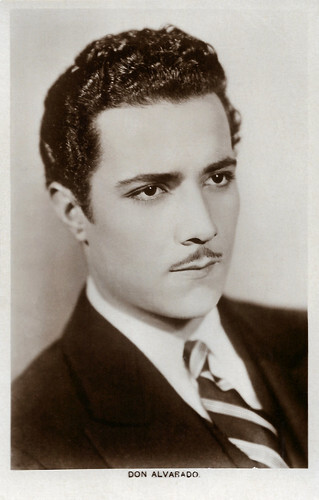
British postcard in the Picturegoer Series, London, no. 348.
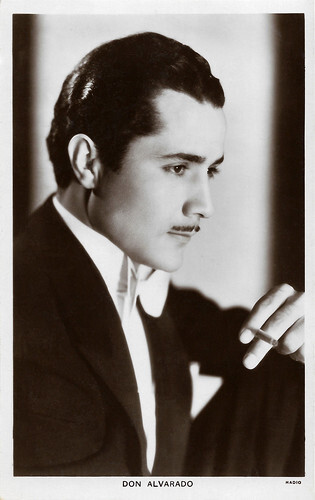
British postcard in the Picturegoer Series, London, no. 348b. Photo: Radio.
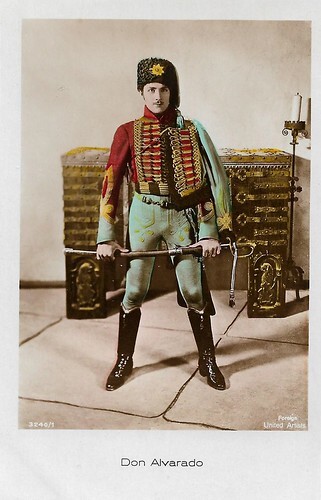
German postcard by Ross Verlag, no. 3240/1, Series Foreign. Photo: United Artists. Don Alvarado in Drums of Love (D.W. Griffith, 1928).
Capitalising on his Latin Lover's looks
Don Alvarado was born José Ray Paige in 1904 in Albuquerque, New Mexico. He first studied agriculture on his father's sheep and cattle ranch. In 1922, at just age 18 he ran away from home and went to Los Angeles, hoping to find acting work in the fledgling silent film industry.
He secured work in a sweet factory before getting into the films working as an extra. While in Los Angeles, he became close friends with the México-born actor, Luis Antonio Dámaso de Alonso, who would later be known as Gilbert Roland . The struggling young actors shared a place for a time.
Alvarado soon met and fell in love with an aspiring actress, sixteen-year-old Ann Boyar, the daughter of Russian Jewish immigrants. They married in 1924. Later that year they had a daughter, actress Joy Page. Don Alvarado got his first uncredited silent film part in the 1924 film, Mademoiselle Midnight (Robert Z. Leonard, 1924) starring Mae Murray .
Jose Paige was given the screen name Don Alvarado by studio chief Jack L. Warner while they purportedly were driving past the Los Angeles street Alvarado. With the studio capitalising on his "Latin Lover" looks, Alvarado was quickly cast in secondary and then leading roles in such films as The Loves of Carmen (Raoul Walsh, 1927) with Dolores del Rio, Drums of Love (D.W. Griffith, 1928) opposite Mary Philbin , and The Scarlet Lady (Alan Crosland, 1928), starring Lya de Putti .
Hans J. Wollstein at AllMovie : "Like the similar Rod La Rocque , Alvarado (born Josè Paige) was perhaps a bit too American; in other words: not perceived as dangerous enough. Best remembered for the two films he did for D.W. Griffith (Drums of Love and The Battle of the Sexes [both 1928]), Alvarado was usually mere fodder for such high-powered female stars as Constance Talmadge , Dolores Del Rio , and Lya De Putti , none of whom found it difficult to steal the limelight from their co-star."
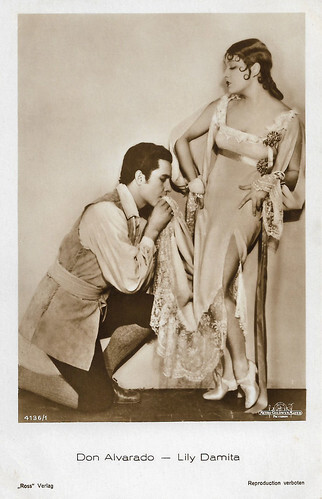
German postcard by Ross Verlag, no. 4136/1, 1929-1930. Photo: Metro Goldwyn Mayer. Don Alvarado and Lily Damita in The Bridge of San Luis Rey (Charles Brabin 1929). The film was shot both as a silent and a sound film.
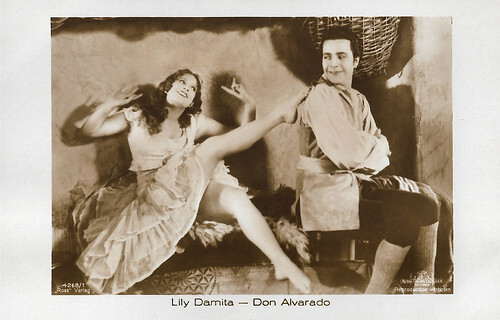
German postcard by Ross Verlag, no. 4268/1, 1929-1930. Photo: Metro-Goldwyn-Mayer. Lily Damita and Don Alvarado in The Bridge of San Luis Rey (Charles Brabin 1929).
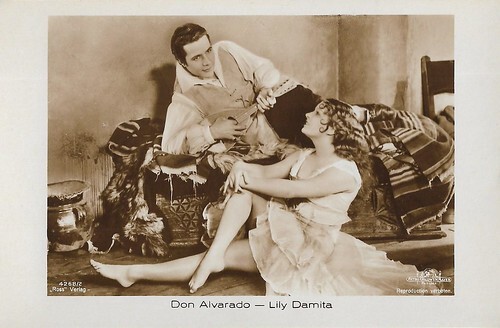
German postcard by Ross Verlag, no. 4268/2, 1929-1930. Photo: Metro Goldwyn Mayer. Don Alvarado and Lily Damita in The Bridge of San Luis Rey (Charles Brabin 1929).
Cast in secondary Spanish character roles
With the advent of talkies, Don Alvarado's starring roles ended. He did, however, manage to work regularly, usually cast in secondary Spanish character roles, such as in the Thornton Wilder adaptation of The Bridge of San Luis Rey (Charles Brabin, 1929) with Lily Damita and the pre-code musical comedy Rio Rita (Luther Reed, 1929) starring Bebe Daniels and John Boles.
After six years of marriage Alvorado's wife, Ann fell in love with the studio head, Jack L. Warner. In 1932, she filed for divorce from Alvarado using what used to be called a "quickie divorce" conveniently available in Mexico. Ann moved in with Warner perhaps as early as September 1933. Warner waited several more years until his parents died before he divorced his wife, Irma, and married Ann in 1936.
Alvarado appeared on stage in 'Dinner At Eight' at the Belasco Theatre in Los Angeles in 1933. In 1939, using the name "Don Page" for screen credit purposes, he began working as an assistant director for Warner Bros. and a few years later as a production manager. In these capacities, he was part of the team that made a number of highly successful films including The Treasure of the Sierra Madre (John Huston, 1948), East of Eden (Elia Kazan, 1955), Rebel Without a Cause (Nicholas Ray, 1955), and his final film work, The Old Man and the Sea (John Sturges, 1958), in which he also appeared in his final, uncredited role as a waiter.
In 1932, Alvarado was briefly engaged to the musical-comedy star Marilyn Miller, but the marriage did not take place. He and his ex-wife Ann remained friends and after a long career as an assistant director, Paige was asked by his former wife if he might like to manage the 80,000-acre Arizona cattle ranch she had purchased with Warner. Page had grown up in cattle country, was an experienced horseman and spoke Spanish. He accepted the job and by all accounts was a respected and much-liked manager.
Don Alvarado died of cancer in 1967, aged 62, in Hollywood, Los Angeles, California and was interred in the Forest Lawn Memorial Park Cemetery in Hollywood Hills. His gravesite has him interred under the name "Joseph Page". For his contributions to the film industry, Alvarado has a star on the Hollywood Walk of Fame at 6504 Hollywood Boulevard.
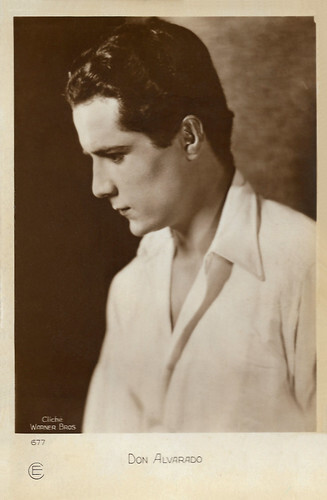
French postcard by Cinémagazine-Edition, no. 677. Photo: Warner Bros.
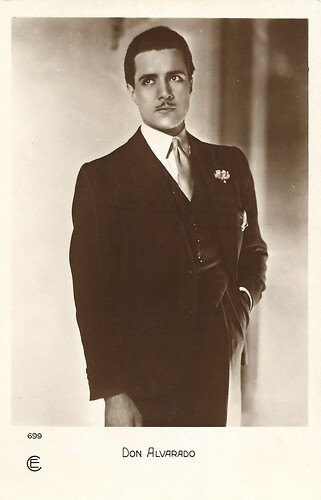
French postcard by Cinémagazine-Edition, no. 699.
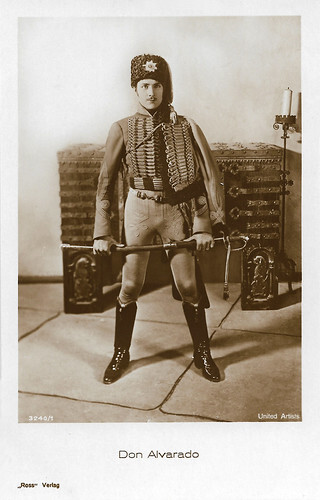
German postcard by Ross Verlag, no. 3240/1, 1928-1929. Photo: United Artists. Don Alvarado in Drums of Love (D.W. Griffith, 1928).
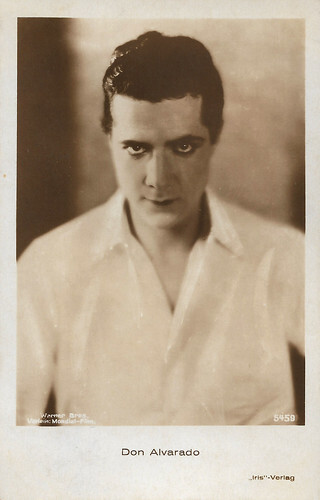
Austrian postcard by Iris Verlag, no. 5459. Photo: Warner Bros / Mondial Film.
Sources: Hans J. Wollstein (AllMovie), Aeri Amadis-Noel (Find a Grave), (IMDb), Wikipedia and .

British postcard in the Picturegoer Series, London, no. 348.

British postcard in the Picturegoer Series, London, no. 348b. Photo: Radio.

German postcard by Ross Verlag, no. 3240/1, Series Foreign. Photo: United Artists. Don Alvarado in Drums of Love (D.W. Griffith, 1928).
Capitalising on his Latin Lover's looks
Don Alvarado was born José Ray Paige in 1904 in Albuquerque, New Mexico. He first studied agriculture on his father's sheep and cattle ranch. In 1922, at just age 18 he ran away from home and went to Los Angeles, hoping to find acting work in the fledgling silent film industry.
He secured work in a sweet factory before getting into the films working as an extra. While in Los Angeles, he became close friends with the México-born actor, Luis Antonio Dámaso de Alonso, who would later be known as Gilbert Roland . The struggling young actors shared a place for a time.
Alvarado soon met and fell in love with an aspiring actress, sixteen-year-old Ann Boyar, the daughter of Russian Jewish immigrants. They married in 1924. Later that year they had a daughter, actress Joy Page. Don Alvarado got his first uncredited silent film part in the 1924 film, Mademoiselle Midnight (Robert Z. Leonard, 1924) starring Mae Murray .
Jose Paige was given the screen name Don Alvarado by studio chief Jack L. Warner while they purportedly were driving past the Los Angeles street Alvarado. With the studio capitalising on his "Latin Lover" looks, Alvarado was quickly cast in secondary and then leading roles in such films as The Loves of Carmen (Raoul Walsh, 1927) with Dolores del Rio, Drums of Love (D.W. Griffith, 1928) opposite Mary Philbin , and The Scarlet Lady (Alan Crosland, 1928), starring Lya de Putti .
Hans J. Wollstein at AllMovie : "Like the similar Rod La Rocque , Alvarado (born Josè Paige) was perhaps a bit too American; in other words: not perceived as dangerous enough. Best remembered for the two films he did for D.W. Griffith (Drums of Love and The Battle of the Sexes [both 1928]), Alvarado was usually mere fodder for such high-powered female stars as Constance Talmadge , Dolores Del Rio , and Lya De Putti , none of whom found it difficult to steal the limelight from their co-star."

German postcard by Ross Verlag, no. 4136/1, 1929-1930. Photo: Metro Goldwyn Mayer. Don Alvarado and Lily Damita in The Bridge of San Luis Rey (Charles Brabin 1929). The film was shot both as a silent and a sound film.

German postcard by Ross Verlag, no. 4268/1, 1929-1930. Photo: Metro-Goldwyn-Mayer. Lily Damita and Don Alvarado in The Bridge of San Luis Rey (Charles Brabin 1929).

German postcard by Ross Verlag, no. 4268/2, 1929-1930. Photo: Metro Goldwyn Mayer. Don Alvarado and Lily Damita in The Bridge of San Luis Rey (Charles Brabin 1929).
Cast in secondary Spanish character roles
With the advent of talkies, Don Alvarado's starring roles ended. He did, however, manage to work regularly, usually cast in secondary Spanish character roles, such as in the Thornton Wilder adaptation of The Bridge of San Luis Rey (Charles Brabin, 1929) with Lily Damita and the pre-code musical comedy Rio Rita (Luther Reed, 1929) starring Bebe Daniels and John Boles.
After six years of marriage Alvorado's wife, Ann fell in love with the studio head, Jack L. Warner. In 1932, she filed for divorce from Alvarado using what used to be called a "quickie divorce" conveniently available in Mexico. Ann moved in with Warner perhaps as early as September 1933. Warner waited several more years until his parents died before he divorced his wife, Irma, and married Ann in 1936.
Alvarado appeared on stage in 'Dinner At Eight' at the Belasco Theatre in Los Angeles in 1933. In 1939, using the name "Don Page" for screen credit purposes, he began working as an assistant director for Warner Bros. and a few years later as a production manager. In these capacities, he was part of the team that made a number of highly successful films including The Treasure of the Sierra Madre (John Huston, 1948), East of Eden (Elia Kazan, 1955), Rebel Without a Cause (Nicholas Ray, 1955), and his final film work, The Old Man and the Sea (John Sturges, 1958), in which he also appeared in his final, uncredited role as a waiter.
In 1932, Alvarado was briefly engaged to the musical-comedy star Marilyn Miller, but the marriage did not take place. He and his ex-wife Ann remained friends and after a long career as an assistant director, Paige was asked by his former wife if he might like to manage the 80,000-acre Arizona cattle ranch she had purchased with Warner. Page had grown up in cattle country, was an experienced horseman and spoke Spanish. He accepted the job and by all accounts was a respected and much-liked manager.
Don Alvarado died of cancer in 1967, aged 62, in Hollywood, Los Angeles, California and was interred in the Forest Lawn Memorial Park Cemetery in Hollywood Hills. His gravesite has him interred under the name "Joseph Page". For his contributions to the film industry, Alvarado has a star on the Hollywood Walk of Fame at 6504 Hollywood Boulevard.

French postcard by Cinémagazine-Edition, no. 677. Photo: Warner Bros.

French postcard by Cinémagazine-Edition, no. 699.

German postcard by Ross Verlag, no. 3240/1, 1928-1929. Photo: United Artists. Don Alvarado in Drums of Love (D.W. Griffith, 1928).

Austrian postcard by Iris Verlag, no. 5459. Photo: Warner Bros / Mondial Film.
Sources: Hans J. Wollstein (AllMovie), Aeri Amadis-Noel (Find a Grave), (IMDb), Wikipedia and .
Published on May 26, 2023 22:00
May 25, 2023
Hanna Schygulla
German actress and chanson singer Hanna Schygulla (1943) was the icon of the New German Cinema of the 1970s and early 1980s. Schygulla was Rainer Werner Fassbinder's muse and anti-star, and over 12 years, she appeared in 23 of his films. After his death in 1982, she worked together with several other major European directors.
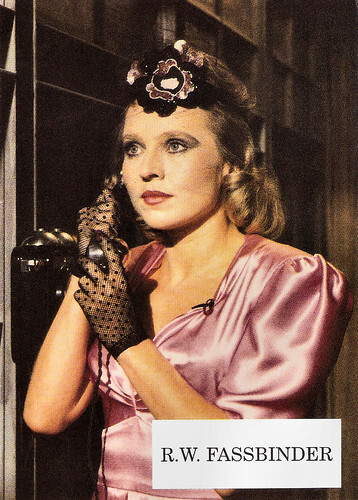
Dutch freecard by Free Card, Haarlem for the R.W. Fassbinder retrospective at Rialto and De Meervaart, Amsterdam 1993 Hanna Schygulla in Lili Marleen (Rainer Werner Fassbinder, 1980).
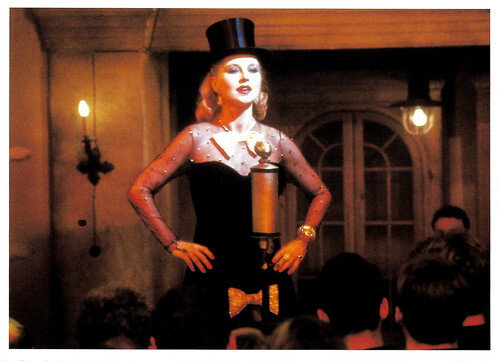
American postcard by Abbeville Publishing Group, New York. Photo: Cinetext, Frankfurt. Hanna Schygulla in Lili Marleen (Rainer Werner Fassbinder, 1980).
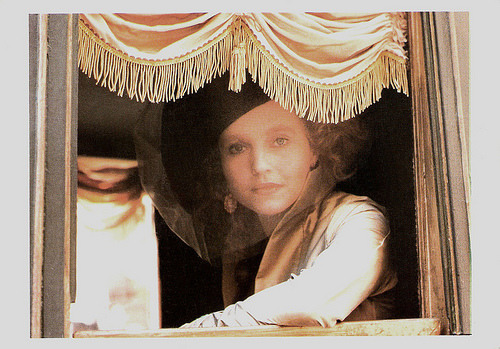
French postcard by Editions La Malibran, Paris, no. MC 21. Photo: publicity still for La Nuit de Varennes (Ettore Scola, 1982).
Love is Colder Than Death
Hanna Schygulla was born in K��nigsh��tte Upper Silesia, a section of Poland annexed by the Third Reich (now Chorz��w in Poland), on Christmas Day 1943. Her parents were Antonie (n��e Mzyk) and Joseph Schygulla, a timber merchant by profession. Her father was drafted as an infantryman in the German Army and was captured by American forces in Italy, subsequently being held as a prisoner of war until 1948, when Hanna was 5. In 1945, Schygulla, and her mother, arrived as refugees in Munich following the expulsion of the majority German population of K��nigsh��tte by Communist Poland.
In the 1960s, Schygulla studied Roman languages and German studies, while taking acting lessons in Munich during her spare time. She met Rainer Werner Fassbinder in 1965 and became a member of his collective theatre troupe, Munich Action Theatre. This group eventually evolved into Fassbinder���s film group, and Schygulla played the female lead in his first feature film Liebe ist k��lter als der Tod/Love is Colder Than Death (Rainer Werner Fassbinder, 1969). The reception was generally negative, and the film was even booed at the 19th Berlin International Film Festival in 1969. Today, it is seen as a fine example of Fassbinder's early style, with a heavy 'Nouvelle Vague' influence. The cast as an ensemble won an award at the German Film Awards in 1970.
She was again the lead actress in Katzelmacher (Rainer Werner Fassbinder, 1969). The film centers on an aimless group of friends whose lives are shaken up by the arrival of an immigrant Greek worker, Jorgos (played by Fassbinder himself, in an uncredited role). Other early Fassbinder films in which she starred were G��tter der Pest/Gods of the Plague (Rainer Werner Fassbinder, 1970) with Margaretha von Trotta and Harry Baer, Rio das Mortes (Rainer Werner Fassbinder, 1971), and the Western Whity (Rainer Werner Fassbinder, 1971) with G��nther Kaufmann.
The filming of Whity in Spain inspired the Semi-autobiographical drama Warnung vor einer heiligen Nutte/Beware of a Holy Whore (Rainer Werner Fassbinder, 1971) featuring Lou Castel, Eddie Constantine, Schygulla and Fassbinder himself. Holed up in a hotel with too much drink, drugs and time, the cast and crew of a film are gradually disintegrating as they await the arrival of their director. Very interesting was also H��ndler der vier Jahreszeiten/The Merchant of Four Seasons (Rainer Werner Fassbinder, 1971) featuring Hans Hirschmueller as a fruit-peddler in 1950s West Germany, who is driven over the edge by an uncaring society.
The following year Schygulla played the object of obsession for fashion designer Petra von Kant (Margit Carstensen) in Die bitteren Tr��nen der Petra von Kant/The Bitter Tears of Petra von Kant (Rainer Werner Fassbinder, 1972). During the making of Effi Briest (1974), an adaptation of a German novel by Theodor Fontane, Fassbinder and Schygulla fell out over divergent interpretations of the character. Another problem for Schygulla was the low pay, and she led a revolt against Fassbinder on this issue during production in 1972. Fassbinder's response was typically blunt: "I can't stand the sight of your face any more. You bust my balls". After the clash, she did not work with him again for five years.
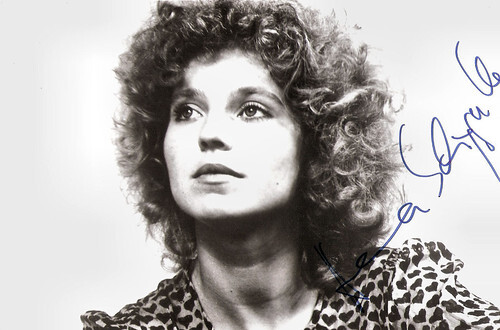
German autograph card.
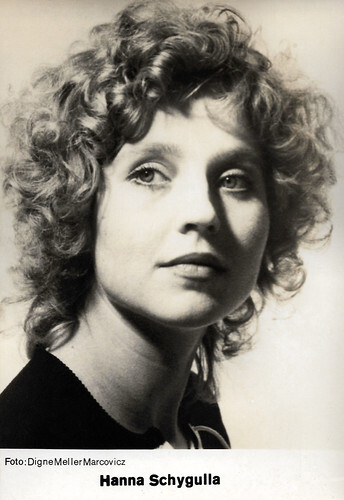
German card. Photo: Digne Meller Marcovicz.
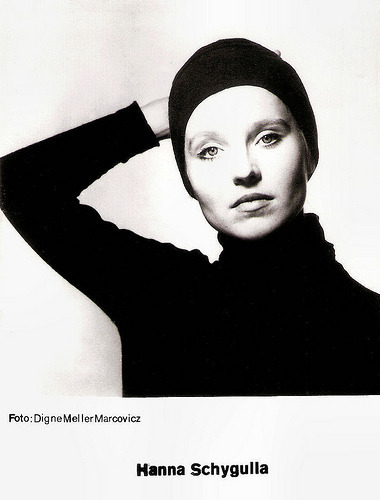
German card. Photo: Digne Meller Marcovicz.
The marriage of Maria Braun
Hanna Schygulla started to work with other film makers. She played the female lead in Falsche Bewegung/The Wrong Move (1975), a road movie directed by one of the other major directors of the New German Cinema, Wim Wenders.
In 1978, she reunited with Fassbinder for one of their greatest successes Die Ehe der Maria Braun/The Marriage of Maria Braun (Rainer Werner Fassbinder, 1979). Schygulla starred as Maria, whose marriage to the soldier Hermann remained unfulfilled due to World War II and his post-war imprisonment. Maria adapts to the realities of post-war Germany and becomes the wealthy mistress of an industrialist, all the while staying true to her love for Hermann. Critic Derek Malcolm called it in The Guardian ���a landmark in German cinema���: ���Schygulla gives a magnificent performance as a vulnerable young woman who becomes a self-confident, independent and competent survivor yet still comes to a bad end, largely because of the basic corruption of her world���. The film was entered into the 29th Berlin International Film Festival, where Schygulla won the Silver Bear for Best Actress for her performance.
She also appeared opposite G��nter Lamprecht in the 14-part television miniseries Berlin Alexanderplatz (1980), adapted and directed by Rainer Werner Fassbinder from the Alfred D��blin novel of the same name. Another success was Lili Marleen (Rainer Werner Fassbinder, 1981), based on the autobiographical novel Der Himmel hat viele Farben (Heaven Has Many Colors) by singer Lale Andersen. The film tells about the forbidden love between the German singer Willie (Schygulla) and the Swiss Jewish composer Robert Mendelssohn (a character based on Rolf Liebermann and played by Giancarlo Giannini), who actively seeks to help an underground group of German Jews during the Third Reich. It was to be her last film with Fassbinder, who died in 1982 at the age of 37.
In the following decade, Schygulla acted in French, Italian and American productions. Among her best known films are La Nuit de Varennes/That Night in Varennes (Ettore Scola, 1982), Passion (Jean-Luc Godard, 1982) with Isabelle Huppert, Storia di Piera/The Story of Piera (Marco Ferreri, 1983) with Huppert and Marcello Mastroianni , Eine Liebe in Deutschland/A Love in Germany (Andrzej Wajda, 1983), and the psychological thriller Dead Again (Kenneth Branagh, 1990) starring Branagh and Emma Thompson. In the 1990s Schygulla also became known and well regarded as a chanson singer. In Juliane Lorenz's documentary film Life, Love and Celluloid (1998), on Fassbinder and related topics, Schygulla performs several songs.
Hanna Schugulla continued to make interesting films, like Werckmeister Harm��ni��k/Werckmeister Harmonies (Bela Tarr, 2000) and Auf der anderen Seite/The Edge of Heaven (Fatih Ak��n, 2007). In 2010, she received the Honorary Golden Bear from the Berlin Film Festival. A year later she played in the Russian film Faust (Alexander Sokurov, 2011), a free interpretation of the Faust legend and its literary adaptations by Johann Wolfgang von Goethe and Thomas Mann. The film won the Golden Lion at the 68th Venice International Film Festival. At the end of 2013, she published her autobiography, 'Wach auf und tr��ume', to mark her 70th birthday. Hanna Schygulla who lived in Paris since 1981, returned to Berlin in 2014. Among her recent films are the French dramas La pri��re/The Prayer (C��dric Kahn, 2018) and Peter von Kant (Fran��ois Ozon, 2022), an adaptation of Die bitteren Tr��nen der Petra von Kant/The Bitter Tears of Petra von Kant in which she played Peter's mother.
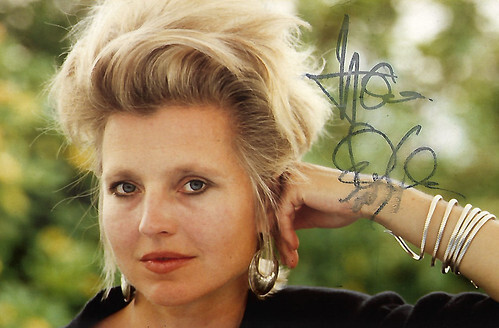
German autograph card.
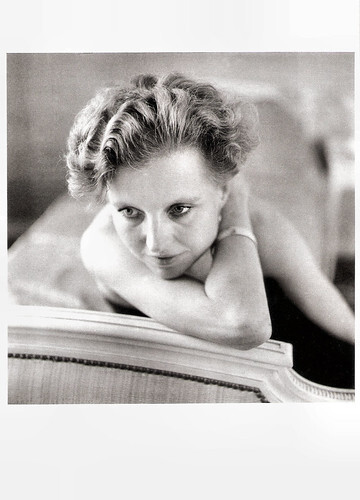
French postcard by Editions Gendre, no. XL 3. Photo: Xavier Lambours. Caption: Hanna Schugulla, Cannes, May 1983.
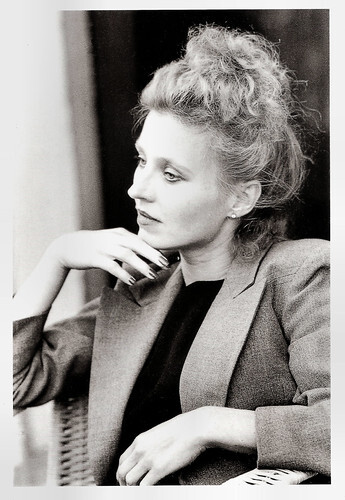
French postcard in the Collection Magie Noire by Editions Hazan, Paris, 1992, no. 6330. Photo: Catherine Faux.
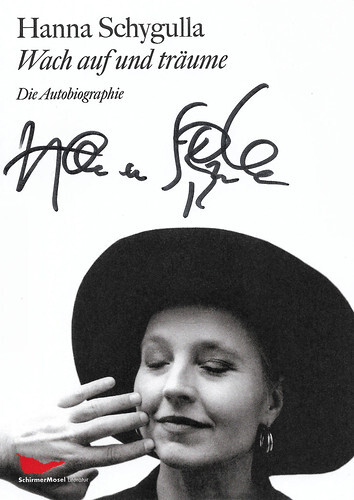
German autograph card. Photo: Lillian Birnbaum, Paris, 1992 (detail). Cover of Hanna Schygulla's autobiography 'Wach auf und tr��ume' (Wake Up and Dream) by SchirmerMosel.
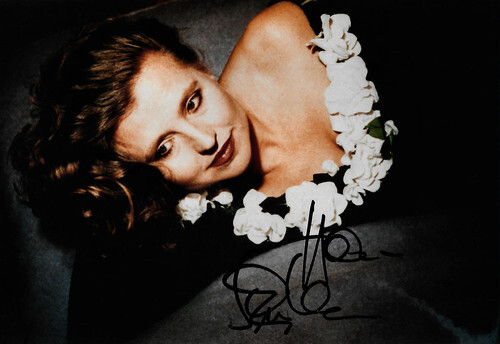
German autograph card.
Scenes from Lili Marleen (Rainer Werner Fassbinder, 1981). Source: Meloclips (YouTube).
Sources: Derek Malcolm (The Guardian), (IMDb), AllMovie, Deutschland.de, Wikipedia, and .

Dutch freecard by Free Card, Haarlem for the R.W. Fassbinder retrospective at Rialto and De Meervaart, Amsterdam 1993 Hanna Schygulla in Lili Marleen (Rainer Werner Fassbinder, 1980).

American postcard by Abbeville Publishing Group, New York. Photo: Cinetext, Frankfurt. Hanna Schygulla in Lili Marleen (Rainer Werner Fassbinder, 1980).

French postcard by Editions La Malibran, Paris, no. MC 21. Photo: publicity still for La Nuit de Varennes (Ettore Scola, 1982).
Love is Colder Than Death
Hanna Schygulla was born in K��nigsh��tte Upper Silesia, a section of Poland annexed by the Third Reich (now Chorz��w in Poland), on Christmas Day 1943. Her parents were Antonie (n��e Mzyk) and Joseph Schygulla, a timber merchant by profession. Her father was drafted as an infantryman in the German Army and was captured by American forces in Italy, subsequently being held as a prisoner of war until 1948, when Hanna was 5. In 1945, Schygulla, and her mother, arrived as refugees in Munich following the expulsion of the majority German population of K��nigsh��tte by Communist Poland.
In the 1960s, Schygulla studied Roman languages and German studies, while taking acting lessons in Munich during her spare time. She met Rainer Werner Fassbinder in 1965 and became a member of his collective theatre troupe, Munich Action Theatre. This group eventually evolved into Fassbinder���s film group, and Schygulla played the female lead in his first feature film Liebe ist k��lter als der Tod/Love is Colder Than Death (Rainer Werner Fassbinder, 1969). The reception was generally negative, and the film was even booed at the 19th Berlin International Film Festival in 1969. Today, it is seen as a fine example of Fassbinder's early style, with a heavy 'Nouvelle Vague' influence. The cast as an ensemble won an award at the German Film Awards in 1970.
She was again the lead actress in Katzelmacher (Rainer Werner Fassbinder, 1969). The film centers on an aimless group of friends whose lives are shaken up by the arrival of an immigrant Greek worker, Jorgos (played by Fassbinder himself, in an uncredited role). Other early Fassbinder films in which she starred were G��tter der Pest/Gods of the Plague (Rainer Werner Fassbinder, 1970) with Margaretha von Trotta and Harry Baer, Rio das Mortes (Rainer Werner Fassbinder, 1971), and the Western Whity (Rainer Werner Fassbinder, 1971) with G��nther Kaufmann.
The filming of Whity in Spain inspired the Semi-autobiographical drama Warnung vor einer heiligen Nutte/Beware of a Holy Whore (Rainer Werner Fassbinder, 1971) featuring Lou Castel, Eddie Constantine, Schygulla and Fassbinder himself. Holed up in a hotel with too much drink, drugs and time, the cast and crew of a film are gradually disintegrating as they await the arrival of their director. Very interesting was also H��ndler der vier Jahreszeiten/The Merchant of Four Seasons (Rainer Werner Fassbinder, 1971) featuring Hans Hirschmueller as a fruit-peddler in 1950s West Germany, who is driven over the edge by an uncaring society.
The following year Schygulla played the object of obsession for fashion designer Petra von Kant (Margit Carstensen) in Die bitteren Tr��nen der Petra von Kant/The Bitter Tears of Petra von Kant (Rainer Werner Fassbinder, 1972). During the making of Effi Briest (1974), an adaptation of a German novel by Theodor Fontane, Fassbinder and Schygulla fell out over divergent interpretations of the character. Another problem for Schygulla was the low pay, and she led a revolt against Fassbinder on this issue during production in 1972. Fassbinder's response was typically blunt: "I can't stand the sight of your face any more. You bust my balls". After the clash, she did not work with him again for five years.

German autograph card.

German card. Photo: Digne Meller Marcovicz.

German card. Photo: Digne Meller Marcovicz.
The marriage of Maria Braun
Hanna Schygulla started to work with other film makers. She played the female lead in Falsche Bewegung/The Wrong Move (1975), a road movie directed by one of the other major directors of the New German Cinema, Wim Wenders.
In 1978, she reunited with Fassbinder for one of their greatest successes Die Ehe der Maria Braun/The Marriage of Maria Braun (Rainer Werner Fassbinder, 1979). Schygulla starred as Maria, whose marriage to the soldier Hermann remained unfulfilled due to World War II and his post-war imprisonment. Maria adapts to the realities of post-war Germany and becomes the wealthy mistress of an industrialist, all the while staying true to her love for Hermann. Critic Derek Malcolm called it in The Guardian ���a landmark in German cinema���: ���Schygulla gives a magnificent performance as a vulnerable young woman who becomes a self-confident, independent and competent survivor yet still comes to a bad end, largely because of the basic corruption of her world���. The film was entered into the 29th Berlin International Film Festival, where Schygulla won the Silver Bear for Best Actress for her performance.
She also appeared opposite G��nter Lamprecht in the 14-part television miniseries Berlin Alexanderplatz (1980), adapted and directed by Rainer Werner Fassbinder from the Alfred D��blin novel of the same name. Another success was Lili Marleen (Rainer Werner Fassbinder, 1981), based on the autobiographical novel Der Himmel hat viele Farben (Heaven Has Many Colors) by singer Lale Andersen. The film tells about the forbidden love between the German singer Willie (Schygulla) and the Swiss Jewish composer Robert Mendelssohn (a character based on Rolf Liebermann and played by Giancarlo Giannini), who actively seeks to help an underground group of German Jews during the Third Reich. It was to be her last film with Fassbinder, who died in 1982 at the age of 37.
In the following decade, Schygulla acted in French, Italian and American productions. Among her best known films are La Nuit de Varennes/That Night in Varennes (Ettore Scola, 1982), Passion (Jean-Luc Godard, 1982) with Isabelle Huppert, Storia di Piera/The Story of Piera (Marco Ferreri, 1983) with Huppert and Marcello Mastroianni , Eine Liebe in Deutschland/A Love in Germany (Andrzej Wajda, 1983), and the psychological thriller Dead Again (Kenneth Branagh, 1990) starring Branagh and Emma Thompson. In the 1990s Schygulla also became known and well regarded as a chanson singer. In Juliane Lorenz's documentary film Life, Love and Celluloid (1998), on Fassbinder and related topics, Schygulla performs several songs.
Hanna Schugulla continued to make interesting films, like Werckmeister Harm��ni��k/Werckmeister Harmonies (Bela Tarr, 2000) and Auf der anderen Seite/The Edge of Heaven (Fatih Ak��n, 2007). In 2010, she received the Honorary Golden Bear from the Berlin Film Festival. A year later she played in the Russian film Faust (Alexander Sokurov, 2011), a free interpretation of the Faust legend and its literary adaptations by Johann Wolfgang von Goethe and Thomas Mann. The film won the Golden Lion at the 68th Venice International Film Festival. At the end of 2013, she published her autobiography, 'Wach auf und tr��ume', to mark her 70th birthday. Hanna Schygulla who lived in Paris since 1981, returned to Berlin in 2014. Among her recent films are the French dramas La pri��re/The Prayer (C��dric Kahn, 2018) and Peter von Kant (Fran��ois Ozon, 2022), an adaptation of Die bitteren Tr��nen der Petra von Kant/The Bitter Tears of Petra von Kant in which she played Peter's mother.

German autograph card.

French postcard by Editions Gendre, no. XL 3. Photo: Xavier Lambours. Caption: Hanna Schugulla, Cannes, May 1983.

French postcard in the Collection Magie Noire by Editions Hazan, Paris, 1992, no. 6330. Photo: Catherine Faux.

German autograph card. Photo: Lillian Birnbaum, Paris, 1992 (detail). Cover of Hanna Schygulla's autobiography 'Wach auf und tr��ume' (Wake Up and Dream) by SchirmerMosel.

German autograph card.
Scenes from Lili Marleen (Rainer Werner Fassbinder, 1981). Source: Meloclips (YouTube).
Sources: Derek Malcolm (The Guardian), (IMDb), AllMovie, Deutschland.de, Wikipedia, and .
Published on May 25, 2023 22:00
May 24, 2023
Liebe (1927)
Austrian star Elisabeth Bergner was one of Germany���s most important theatre stars of the 1920s andwas also very successful in Weimar cinema. She starred in Liebe/ Love (1927), directed by Paul Czinner, her life-partner (they married in 1933), and based on the novel 'La Duchesse de Langeais' (1834) by Honor�� de Balzac, part of a trilogy of novels that Balzac grouped under the title 'Histoire des treize'.
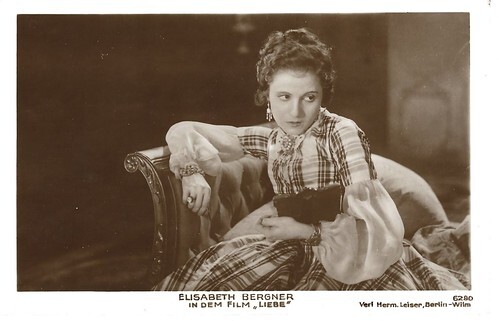
German postcard by Verlag Hermann Leiser, Berlin, no. 6280. Photo: Phoebus-Film. Elisabeth Bergner in Liebe/Love (Paul Czinner, 1927).
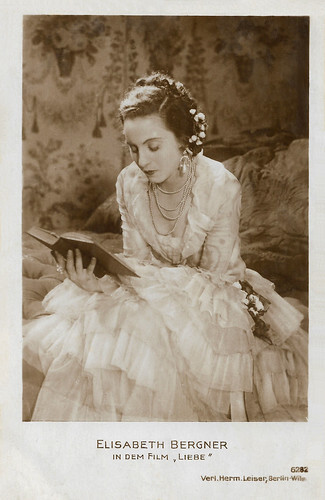
German postcard by Verlag Hermann Leiser, Berlin, no. 6282. Photo: Phoebus-Film Elisabeth Bergner in Liebe/Love (Paul Czinner, 1927).
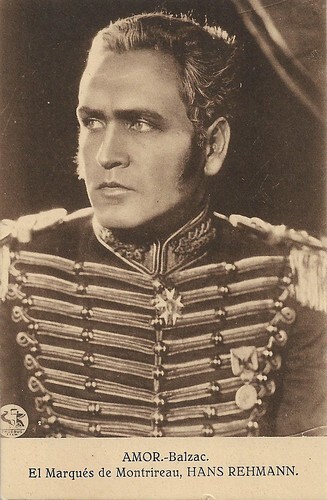
Spanish postcard by Grafos, Madrid. Photo: Phoebus Film. Hans Rehmann in Liebe/Love (Paul Czinner, 1926).
True love awakens
Elisabeth Bergner plays in Liebe/Love (1927) the headstrong, seductive, and tragically fallible Duchess Antoinette de Langeais, a lady of Parisian society, in the mid-19th century.
Antoinette coquettishly plays with the Marquis of Montriveau (Hans Rehmann), a high officer who is in love with her.
When he realises that he is being made a fool of, he gives her the cold shoulder. And now true love awakens in the Duchess. She writes passionate love letters to the Marquis and compromises herself in public to win him over.
She even enters his apartment disguised as a maid, and when she finds her letters there unopened, she goes to a convent in despair. Only now does the Marquis realise that the Duchess really loved him.
After years of searching, the Marquis tracks her down in the convent. Faced with the decision of betraying God or her love, she chooses death.
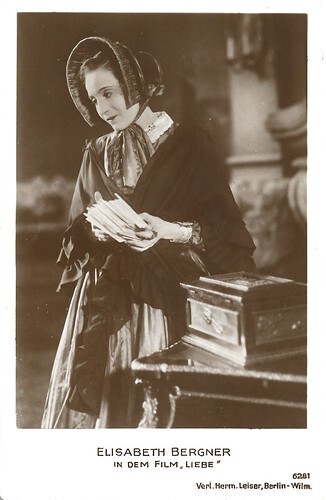
German postcard by Verlag Hermann Leiser, Berlin, no. 6281. Photo: Phoebus-Film. Elisabeth Bergner in Liebe/Love (Paul Czinner, 1927).
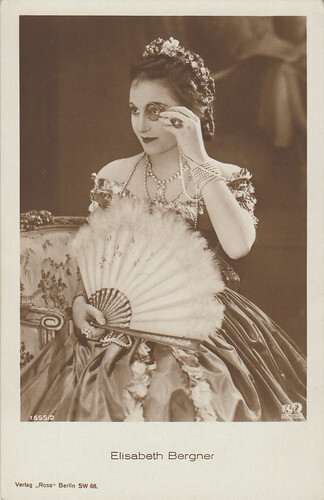
German postcard by Ross Verlag, no. 1655/2, 1927-1928. Photo: Phoebus-Film. Elisabeth Bergner in Liebe/Love (Paul Czinner, 1927). Collection: Marlene Pilaete.
The secret of her success
Liebe (1927) was made in the autumn of 1926 in the Staaken film studios. The six-act film with a length of 2697 metres had its premiere on 3 January 1927 and was awarded the rating "Volksbildend K��nstlerisch".
The Swiss theatre actor Hans Rehmann made his film debut here as the Marquis of Montriveau, knave of Elisabeth Bergner 's Duchess. Hermann Warm designed the film sets, which were executed by Ferdinand Bellan. Ilse Fehling created costumes, that rather look the 1860s than 1830s.
Reviews in Germany were ecstatic, with most newspapers commentating on the prolonged ovation during the opening, when Bergner wasn���t allowed to leave the stage. "The way this soulful artist allows us to experience a fate in the film Liebe is a new proof of her high art." (Vorw��rts, January 1927), " Elisabeth Bergner is the beginning, middle and end of the play ... she is a human being: tormented and cheerful, dark and alluring, a whimsical, an unpredictable enchantress. That is the secret of her success." (8 Uhr-Abendblatt, January 1927),
" Elisabeth Bergner delicious in appearance and movement. A wealth of emotion shines and plays against the rigid uniformity of Hans Rehmann, the antagonist of fate." (Berliner Tageblatt, January 1927), "From the scene where Bergner, wrapped in her cloak and shivering, waits for her lover on a nightly street, the scene at the bars of the monastery has not much equal in dramatic strength. And when she sinks down in front of the crucifix, this real tragedy of love dissolves into a deep minor chord that resonates in the heart for a long time ..." (Lichtbild-B��hne, January 1927),
"It was more than a great film success, it was the breakthrough of a special German film, not to be imitated in any country, and therefore effective in every country. The film is not German because of its subject matter. (...) This film is German because it juxtaposes the language of the German fairy tale with something organically equivalent." (B.Z. am Mittag, January 1927), "Bergner has wonderful scenes. Inimitable, how she starts a conversation. Or she plays with a cat. Or romps around the room. Or costars with him, the tall man in love." (Film-Kurier, 1927).
In subsequent discussions of Liebe/Love, the film was less appreciated and for decades, Liebe/Love remained one of the least appreciated of the Czinner-Bergner collaborations. Jay Weissberg presented the film in 2018 at Le Giornate del Cinema Muto and wrote in the festival catalogue "when viewed through a Balzac lens the film is ripe for re-evaluation". He cites the French critic Henry Poulaille, who wrote in 1928: "We may add that this lovely film comes at the right time. It is a respectful nod by one of the young masters of the universal language that is Cinema, to the great Balzac, his senior, who also, with his pen, addressed the universe."
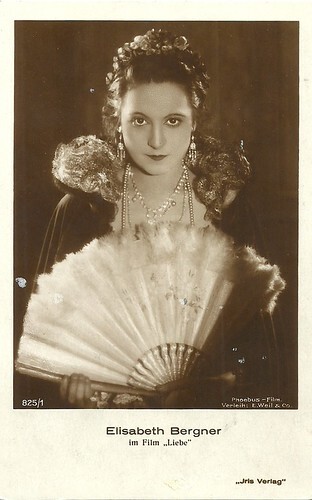
Austrian postcard by Iris Verlag, no. 825/1. Photo: Phoebus-Film / Distr. E. Weil & Co. Elisabeth Bergner in Liebe/Love (Paul Czinner, 1927).
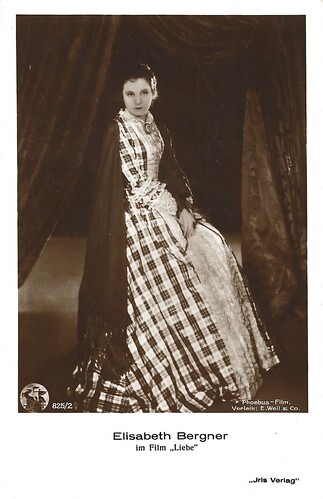
Austrian postcard by Iris Verlag, no. 825/2 Photo: Phoebus-Film / Distr. E. Weil & Co. Elisabeth Bergner in Liebe/Love (Paul Czinner, 1927).
Sources: Antti Alanen: Film Diary, Filmportal.de (German), Wikipedia (German) and IMDb.

German postcard by Verlag Hermann Leiser, Berlin, no. 6280. Photo: Phoebus-Film. Elisabeth Bergner in Liebe/Love (Paul Czinner, 1927).

German postcard by Verlag Hermann Leiser, Berlin, no. 6282. Photo: Phoebus-Film Elisabeth Bergner in Liebe/Love (Paul Czinner, 1927).

Spanish postcard by Grafos, Madrid. Photo: Phoebus Film. Hans Rehmann in Liebe/Love (Paul Czinner, 1926).
True love awakens
Elisabeth Bergner plays in Liebe/Love (1927) the headstrong, seductive, and tragically fallible Duchess Antoinette de Langeais, a lady of Parisian society, in the mid-19th century.
Antoinette coquettishly plays with the Marquis of Montriveau (Hans Rehmann), a high officer who is in love with her.
When he realises that he is being made a fool of, he gives her the cold shoulder. And now true love awakens in the Duchess. She writes passionate love letters to the Marquis and compromises herself in public to win him over.
She even enters his apartment disguised as a maid, and when she finds her letters there unopened, she goes to a convent in despair. Only now does the Marquis realise that the Duchess really loved him.
After years of searching, the Marquis tracks her down in the convent. Faced with the decision of betraying God or her love, she chooses death.

German postcard by Verlag Hermann Leiser, Berlin, no. 6281. Photo: Phoebus-Film. Elisabeth Bergner in Liebe/Love (Paul Czinner, 1927).

German postcard by Ross Verlag, no. 1655/2, 1927-1928. Photo: Phoebus-Film. Elisabeth Bergner in Liebe/Love (Paul Czinner, 1927). Collection: Marlene Pilaete.
The secret of her success
Liebe (1927) was made in the autumn of 1926 in the Staaken film studios. The six-act film with a length of 2697 metres had its premiere on 3 January 1927 and was awarded the rating "Volksbildend K��nstlerisch".
The Swiss theatre actor Hans Rehmann made his film debut here as the Marquis of Montriveau, knave of Elisabeth Bergner 's Duchess. Hermann Warm designed the film sets, which were executed by Ferdinand Bellan. Ilse Fehling created costumes, that rather look the 1860s than 1830s.
Reviews in Germany were ecstatic, with most newspapers commentating on the prolonged ovation during the opening, when Bergner wasn���t allowed to leave the stage. "The way this soulful artist allows us to experience a fate in the film Liebe is a new proof of her high art." (Vorw��rts, January 1927), " Elisabeth Bergner is the beginning, middle and end of the play ... she is a human being: tormented and cheerful, dark and alluring, a whimsical, an unpredictable enchantress. That is the secret of her success." (8 Uhr-Abendblatt, January 1927),
" Elisabeth Bergner delicious in appearance and movement. A wealth of emotion shines and plays against the rigid uniformity of Hans Rehmann, the antagonist of fate." (Berliner Tageblatt, January 1927), "From the scene where Bergner, wrapped in her cloak and shivering, waits for her lover on a nightly street, the scene at the bars of the monastery has not much equal in dramatic strength. And when she sinks down in front of the crucifix, this real tragedy of love dissolves into a deep minor chord that resonates in the heart for a long time ..." (Lichtbild-B��hne, January 1927),
"It was more than a great film success, it was the breakthrough of a special German film, not to be imitated in any country, and therefore effective in every country. The film is not German because of its subject matter. (...) This film is German because it juxtaposes the language of the German fairy tale with something organically equivalent." (B.Z. am Mittag, January 1927), "Bergner has wonderful scenes. Inimitable, how she starts a conversation. Or she plays with a cat. Or romps around the room. Or costars with him, the tall man in love." (Film-Kurier, 1927).
In subsequent discussions of Liebe/Love, the film was less appreciated and for decades, Liebe/Love remained one of the least appreciated of the Czinner-Bergner collaborations. Jay Weissberg presented the film in 2018 at Le Giornate del Cinema Muto and wrote in the festival catalogue "when viewed through a Balzac lens the film is ripe for re-evaluation". He cites the French critic Henry Poulaille, who wrote in 1928: "We may add that this lovely film comes at the right time. It is a respectful nod by one of the young masters of the universal language that is Cinema, to the great Balzac, his senior, who also, with his pen, addressed the universe."

Austrian postcard by Iris Verlag, no. 825/1. Photo: Phoebus-Film / Distr. E. Weil & Co. Elisabeth Bergner in Liebe/Love (Paul Czinner, 1927).

Austrian postcard by Iris Verlag, no. 825/2 Photo: Phoebus-Film / Distr. E. Weil & Co. Elisabeth Bergner in Liebe/Love (Paul Czinner, 1927).
Sources: Antti Alanen: Film Diary, Filmportal.de (German), Wikipedia (German) and IMDb.
Published on May 24, 2023 22:00
Paul van Yperen's Blog
- Paul van Yperen's profile
- 13 followers
Paul van Yperen isn't a Goodreads Author
(yet),
but they
do have a blog,
so here are some recent posts imported from
their feed.



